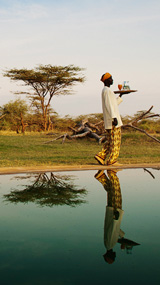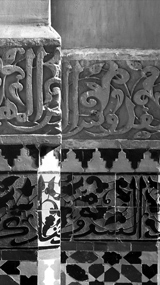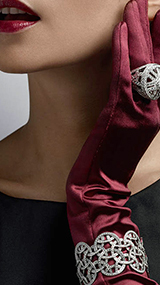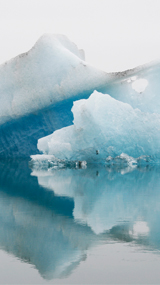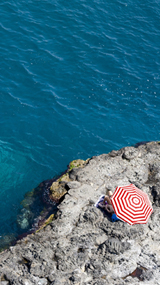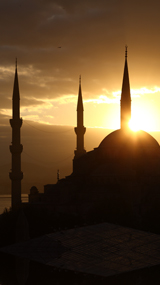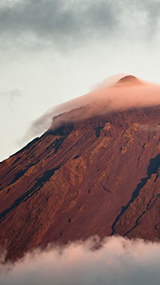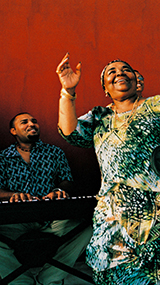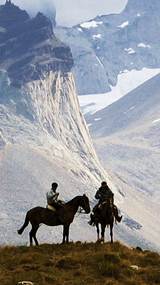
-
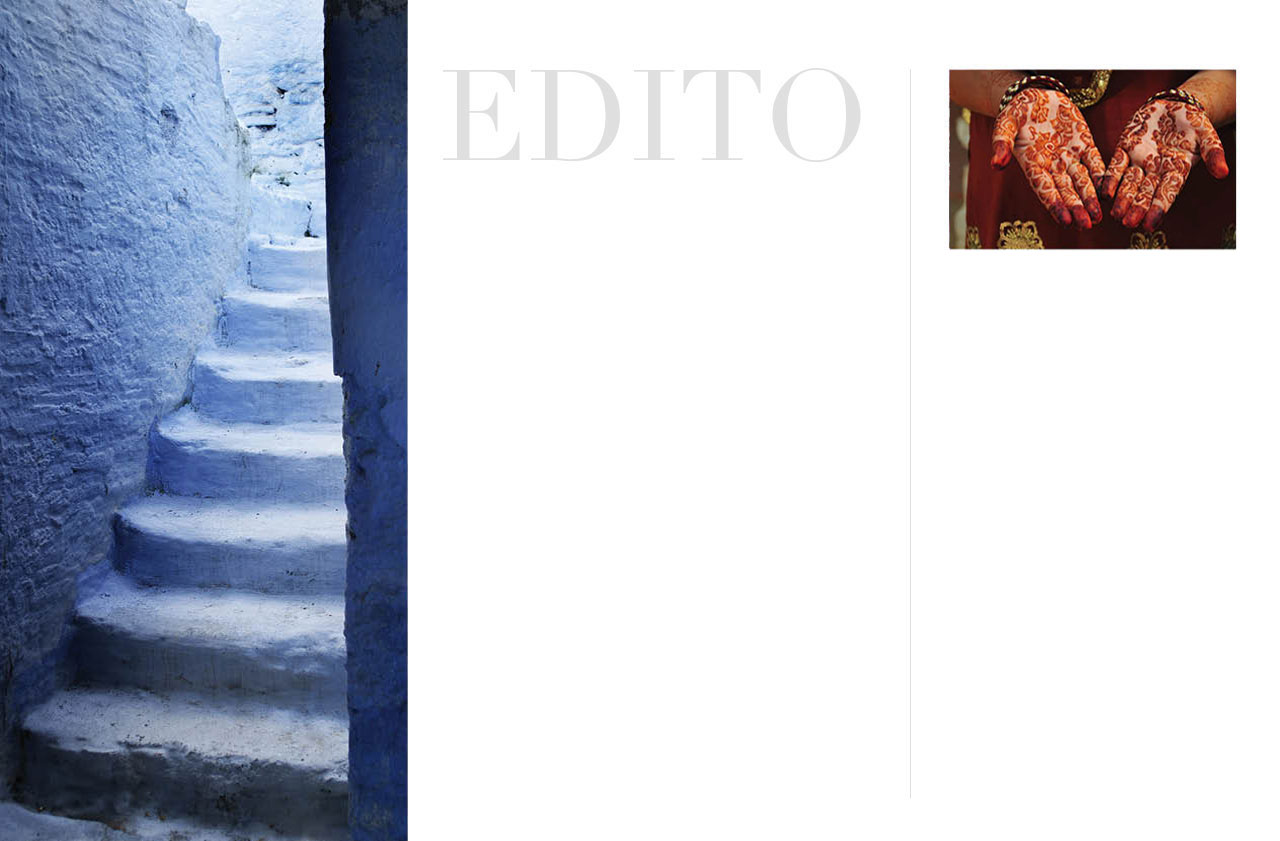
It is time to go back to work with a brand new outlook.
We are back from holidays with a fresh tan and plenty of new ideas, projects and energy. And the same goes with our magazine: after a summer revamp, it brings you more sections, more lifestyle and luxury, as well as an exciting selection of travel reporters and exciting new friends. In our next issues, you will get to travel with more very special guests.
You will discover new destinations, with special issues on dream holidays and an insight into all the latest trends.
We hope that this issue, with its fresh stories and selected images, will enthuse you with some of our sunshine and motivation.
Get ready to travel better and further away!
Jorge Apesteguia-Peña
Contents
- 01
HERE&NOW
- 02
PEOPLE&PLACES
Scotland by Thierry Benitah
The Rioja, tradition and innovation
Mora Vola, dolce vita - 03
Travel essentials
- 04
BEST OF
- 05
TOP LUXE/DESIGN
- 06
LIFE&STYLE
-
- 01
-
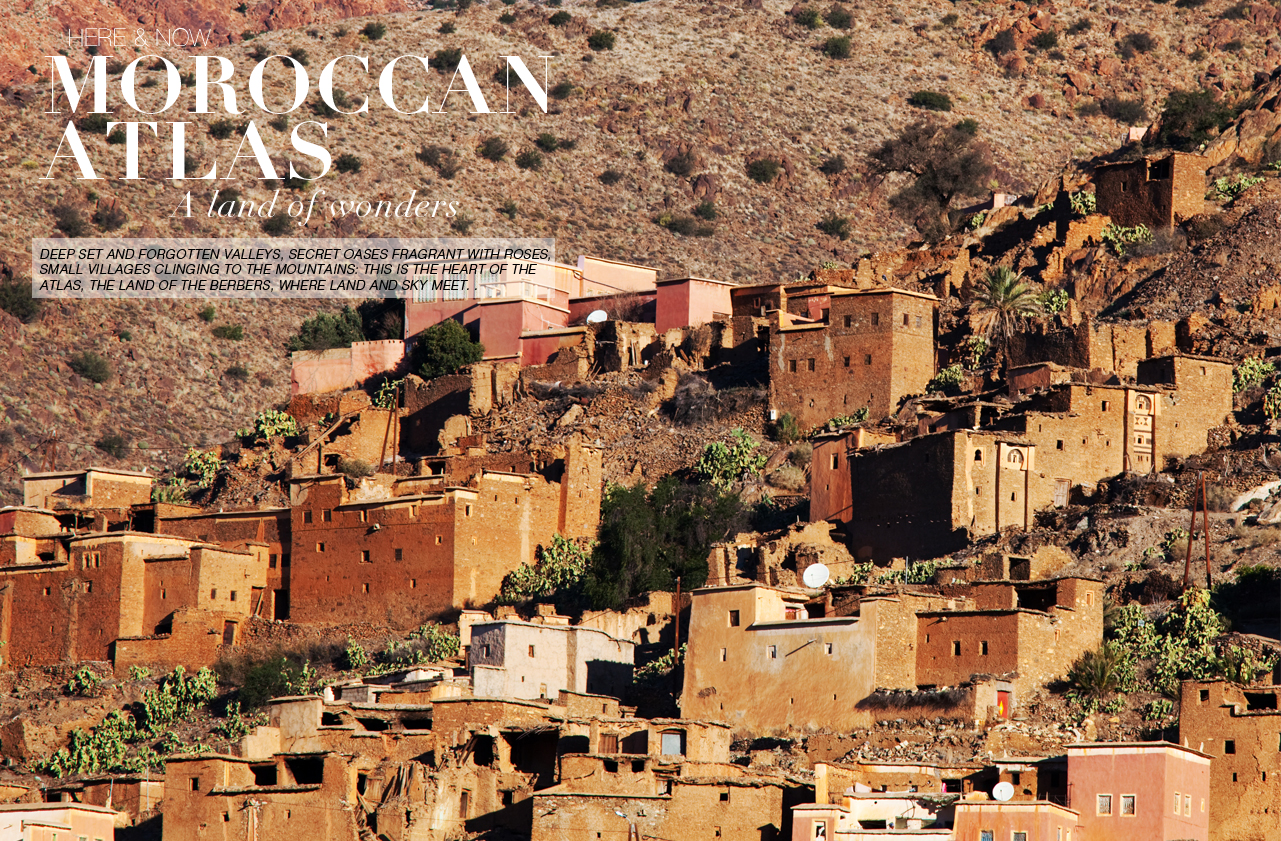
-
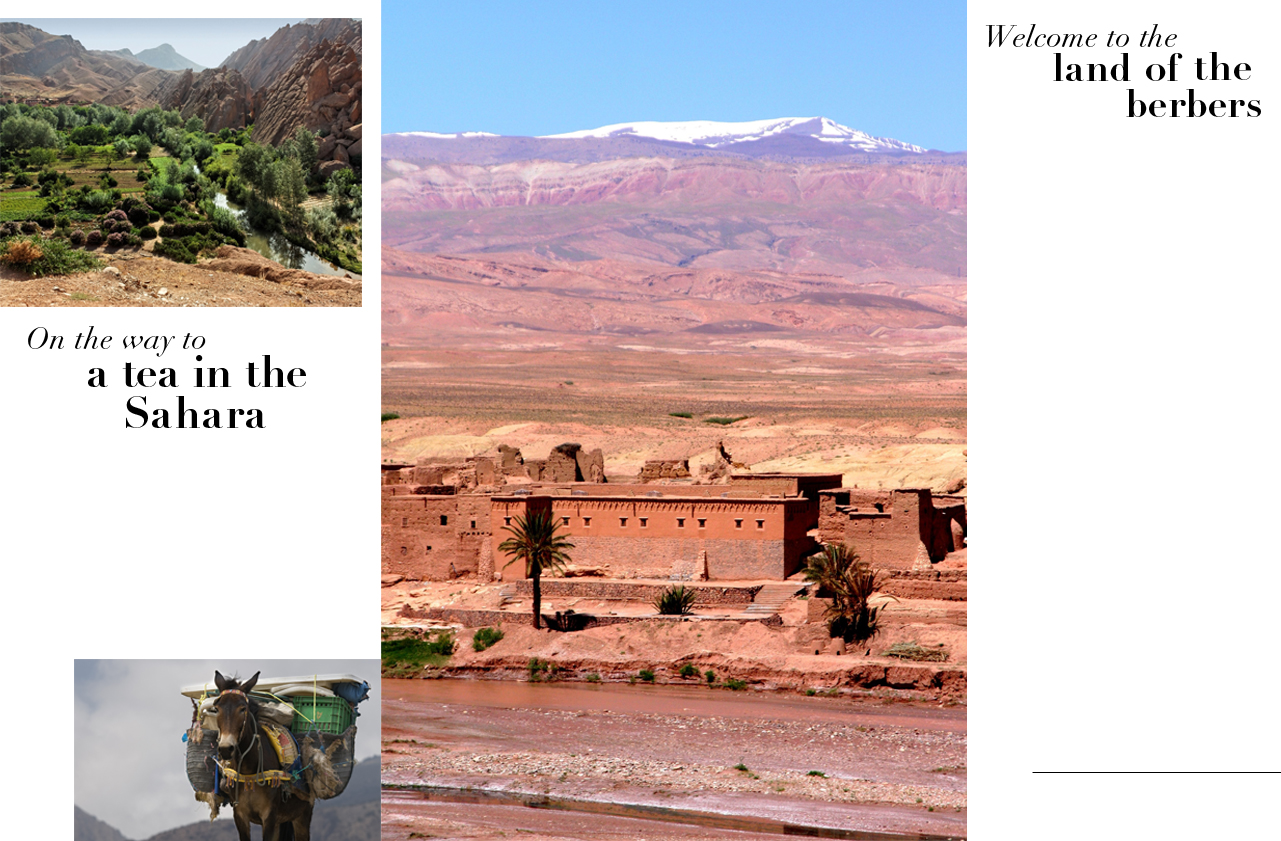
Geographically speaking, the Atlas is a mountain range that runs from the straight of Gibraltar to the gates of Mauritania. It stretches across Morocco, Algeria and Tunisia. According to the legend, it owes its name to the giant Atlas who was condemned by Zeus to carry the celestial vault on his shoulders. Its highest peak, Mount Toubkal, rises at 4,167 meters. It stands in the Atlas’ Moroccan part: the area called the Higher Atlas.
Sometimes, from Marrakech, you can see the Atlas. To get a taste for the place, you just need to drive West out of the city. The track soon becomes a hilly road before reaching the foothills. This is the Ourika valley, where you will find Morocco’s only aromatic botanical garden. Driving on, you will reach the higher valleys. Those have long remained out of the most popular trekking circuits, but trekkers are now discovering the valleys’ beauty and preserved authenticity. For centuries, those mountain paths have been used by the nomads and their herds. The tracks will take you around small villages, clay houses and terraced fields. A great alternative to the desert, they are best visited between May and October.
Climbing up Mount Toubkal is like reaching North Africa’s rooftop, walking the highlands on the nomads’ footsteps. A trek in the Higher Atlas will take you through the lush Bougmez valley, and the red land of the Tessaout region. The landscape is mineral, with red ochres, terraced paths overlooking a patchwork of cultivated fields, and the roar of the Tessaout river down below, heavy with sediments from the M’Goun.
-
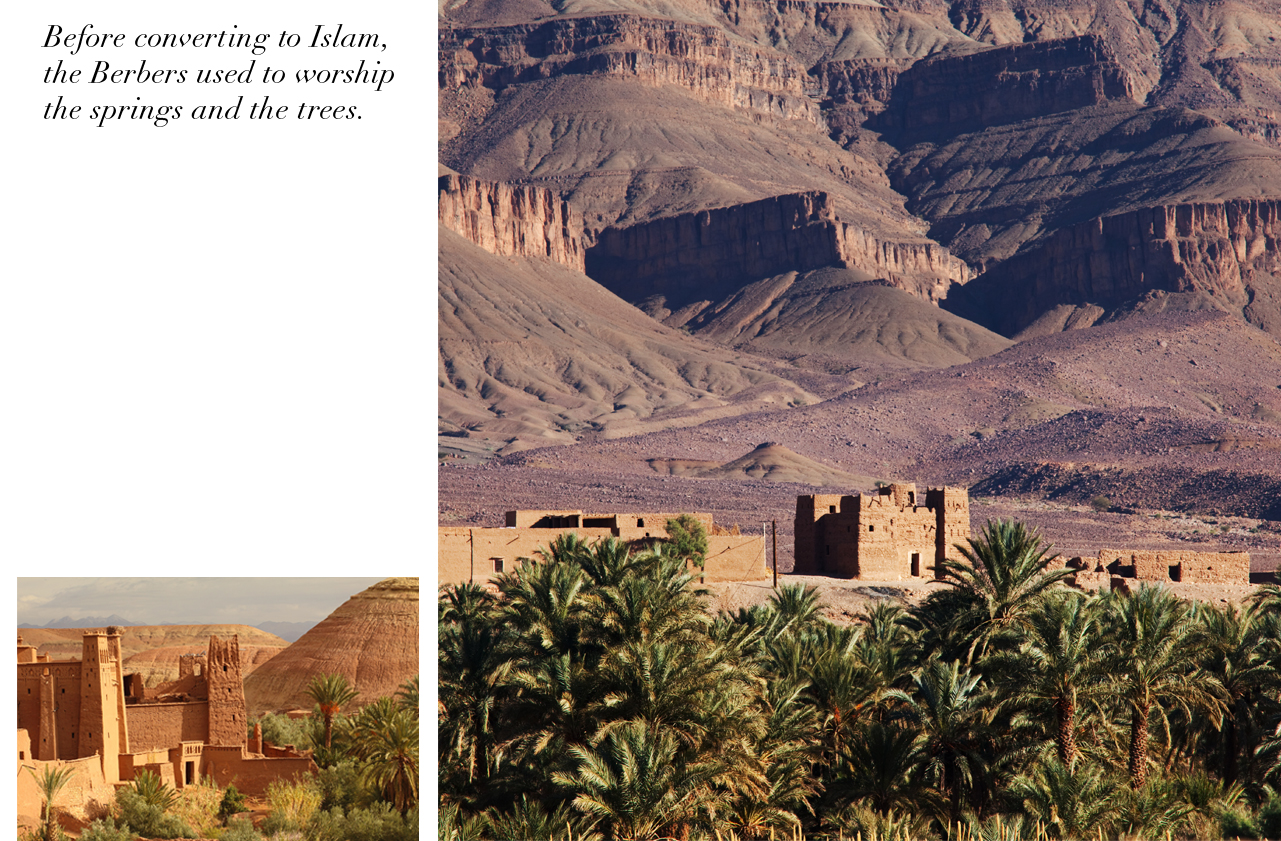
The Tessaout valley is also called “the lost valley”, as it was notoriously difficult to access. It is one of the Atlas’ most beautiful valleys. Its small villages, clinging to the mountainside, will blow you away. Its fortified constructions surrounded by lush gardens were used by the powerful Glaoui to control the caravans passing through on the road to Marrakech. This great chief from the Berber tribe of the Glaoua once was the Pacha of Marrakech. His palace still has its harem and an Andalucía-inspired reception hall. Jacques Majorelle was impressed by the kasbahs’ grandiose architecture, and painted them.
Soon the villages make way for steeper mountainsides. The valley becomes a two meter-wide canyon, at the bottom of a 600 meters drop. You can let the current push you all the way down the valley until it opens out again. You can then follow the bed of the M’Goun river until the large village of Irghem Aqdim, following irrigation canals around a labyrinth of terraced fields.
The lush greenery is a welcome break from the aridity of the mountaintops: it is time for a rest in the shade of the date palms, orange trees and fig trees…
-
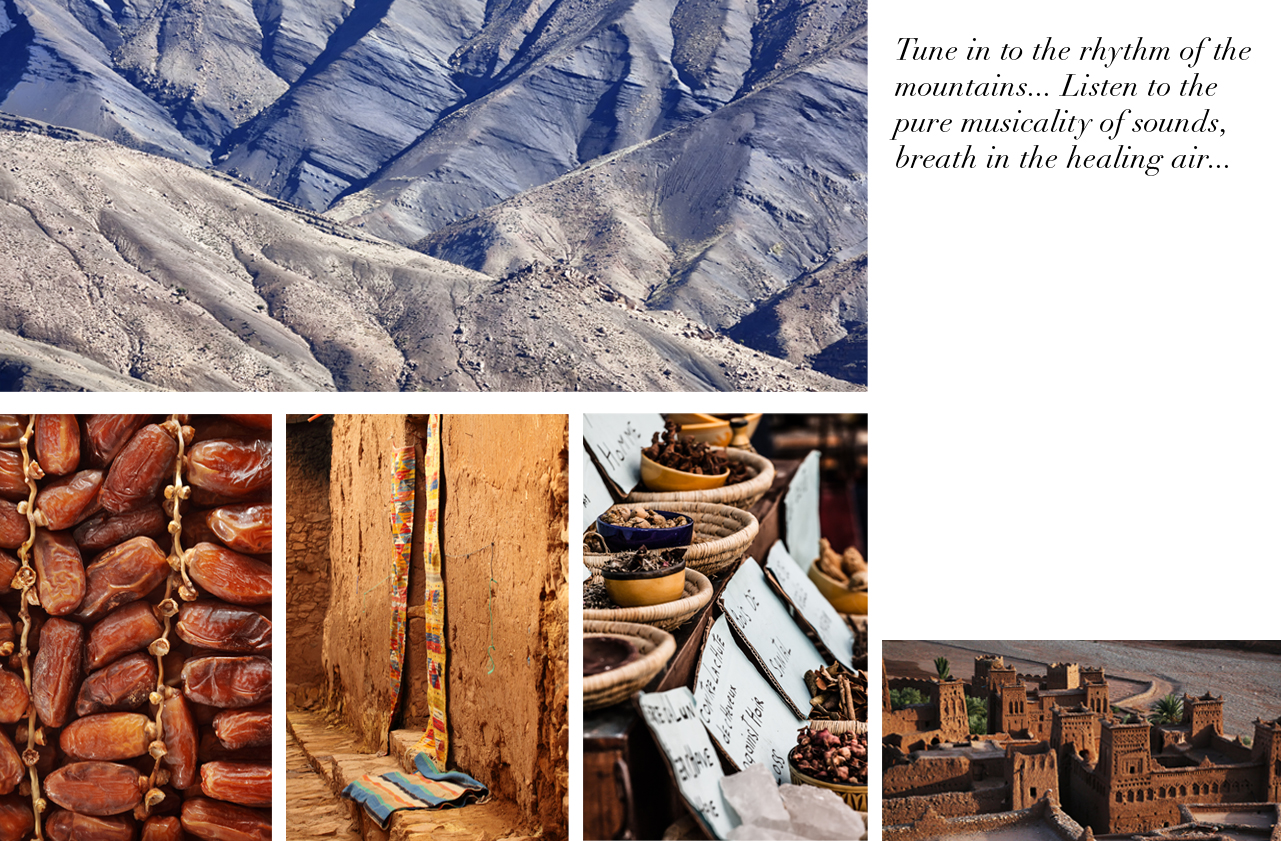
Another walking trail connects Mount Toubkal with the M’Goun river, which runs between the snows of the Higher Atlas and the arid Saghro Massif. Following the M’Goun and its canyons is a wonderful trek that will take you to the valley of roses and to Dadès’ thousand kasbahs. The valley is scattered with kasbahs and unique fortified villages. You will sometimes need to leave the road to discover the traditional Berber dwellings made of raw clay. For over six centuries, in the valleys of the M’Goun and Dadès rivers, rose trees have been cultivated at an altitude of over 1,500 meters. You can only access the rose orchards by walking in and out of the streams, down the canyon. Following the Dadès, you walk
through a land of roses: El Kelaât M’Gouna. This is where rosewater is made: Moroccan women’s favorite beauty secret. In May, the whole region celebrates roses during a three-day festival. Further on, you will reach the Todra Gorge: the canyon becomes deeper and narrower above you. Depending on the time of the day, the rocks take on pink, red, orange or purple hues. Further South is the Sahro djebel, famous for its hundred and fifty different species of birds: it is also known as the Valley of Birds. Carrying on even further South, you will come upon the valley of the Drâa, a river that runs along a narrow oasis of two hundred kilometers, where dates and henna grow.
-
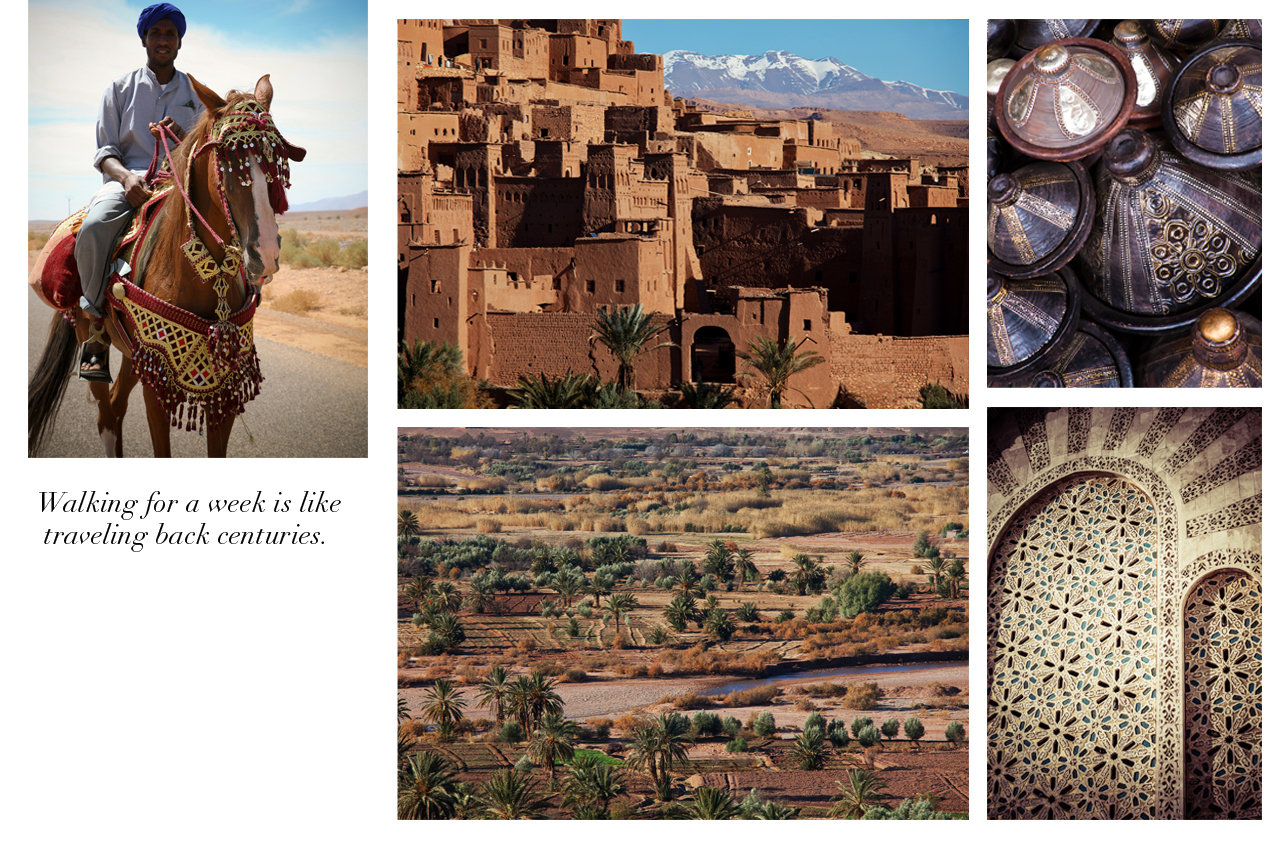
Finally, close to Marrakech is the Yagour: a gigantic plateau that runs along Mount Toubkal, between the Tizi n’Tichka river and the Ourika’s higher valley. It is bordered by impressive cliffs, which can be seen from Marakkech when the weather is clear. The area’s stunning villages are a traditional stopover in the nomadic tribes’ transhumance, and they are amongst the most beautiful in the Atlas.
The site also has ancient rock engravings: about twenty engraved slabs of sandstone going back to 2,500 to 3,000 BC have been found, covered in over a thousand engravings. You can visit the site for a family day out, and stay in a private home for the night: just like in the days of the caravans…
-
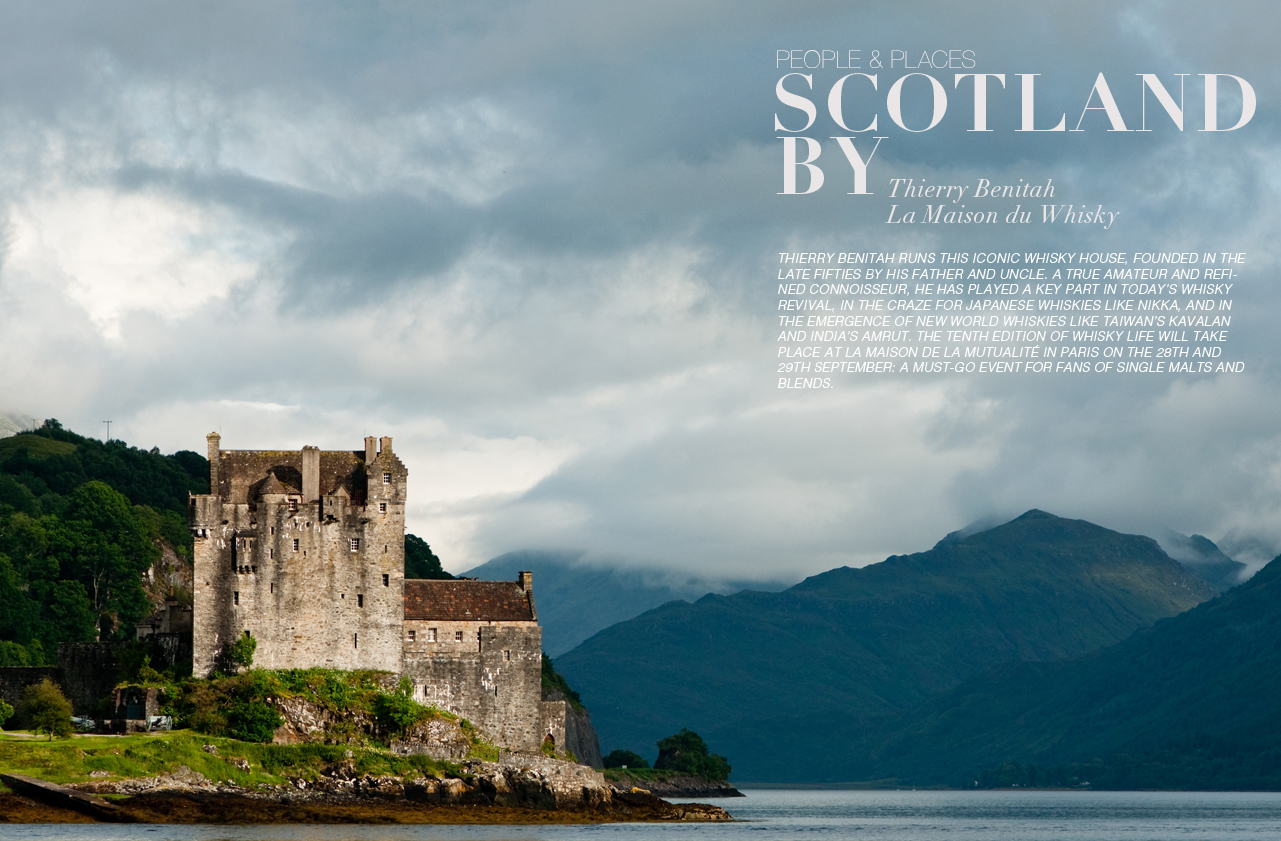
-
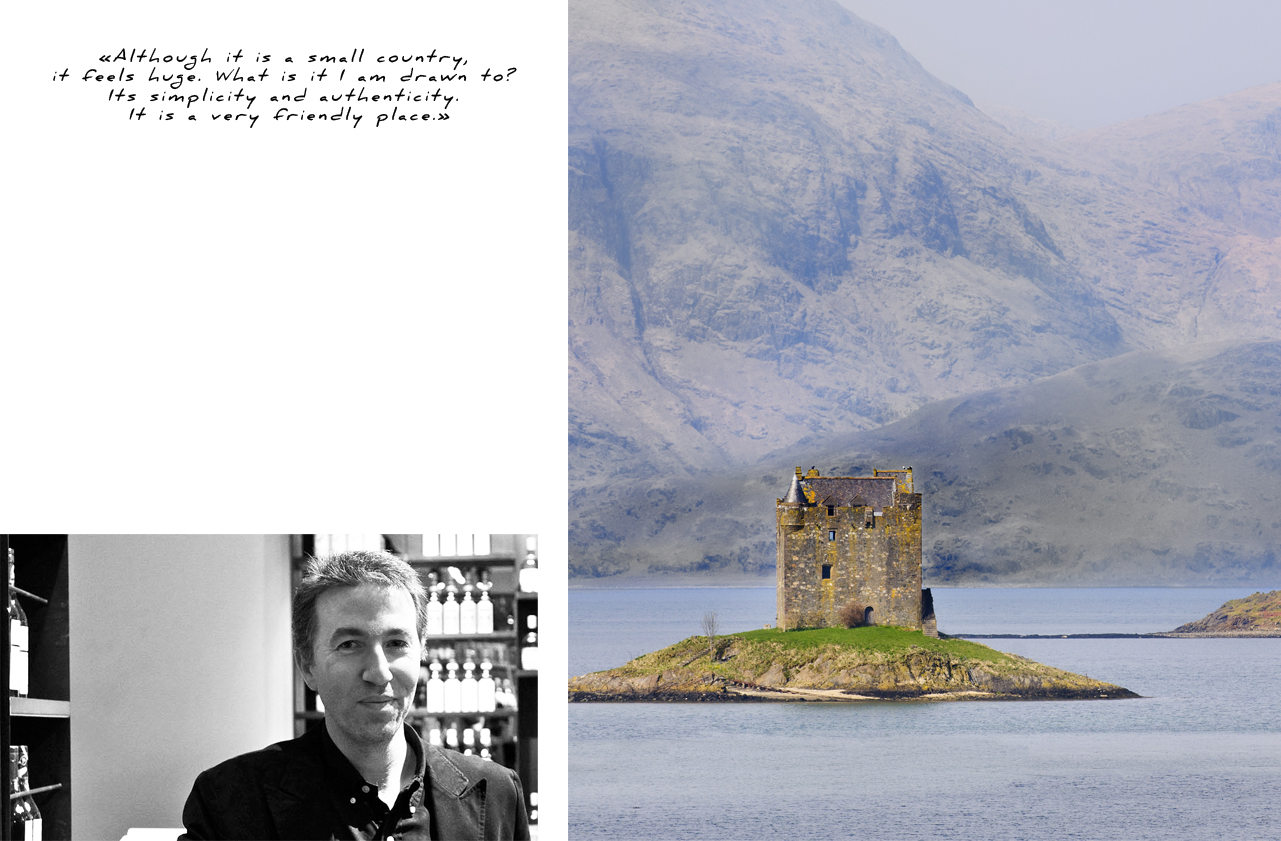
My taste for travel came from my education: as a child, I was lucky enough to spend my holidays abroad. Since then, every time I’ve been on holiday, I have crossed a border. Rather than discovering stunning landscapes, trekking or visiting exhibitions, I like to go on an adventure in a new city and follow my intuition.
No program or guided tour for me: I prefer to improvise, to trust my instinct and experience each new place with the people who live there. In Japan for instance I was lucky to be able to live like the locals.
When you arrive in Edinburgh in July, it is always a surprise: your nose is tickled by the perfume of roasted barley escaping from the distilleries. The very first times, I found the smell overpowering. Now I barely notice it. In the winter or the autumn, the smell is more gentle because the malting period is over.
As soon as you leave the airport you can feel the pressure drop. You don’t feel the same stress as in big capitals. You can just relax. I am not really into nature, and more of a Paris-New York-Tokyo kind of person, but I can’t get enough of this atmosphere.
-
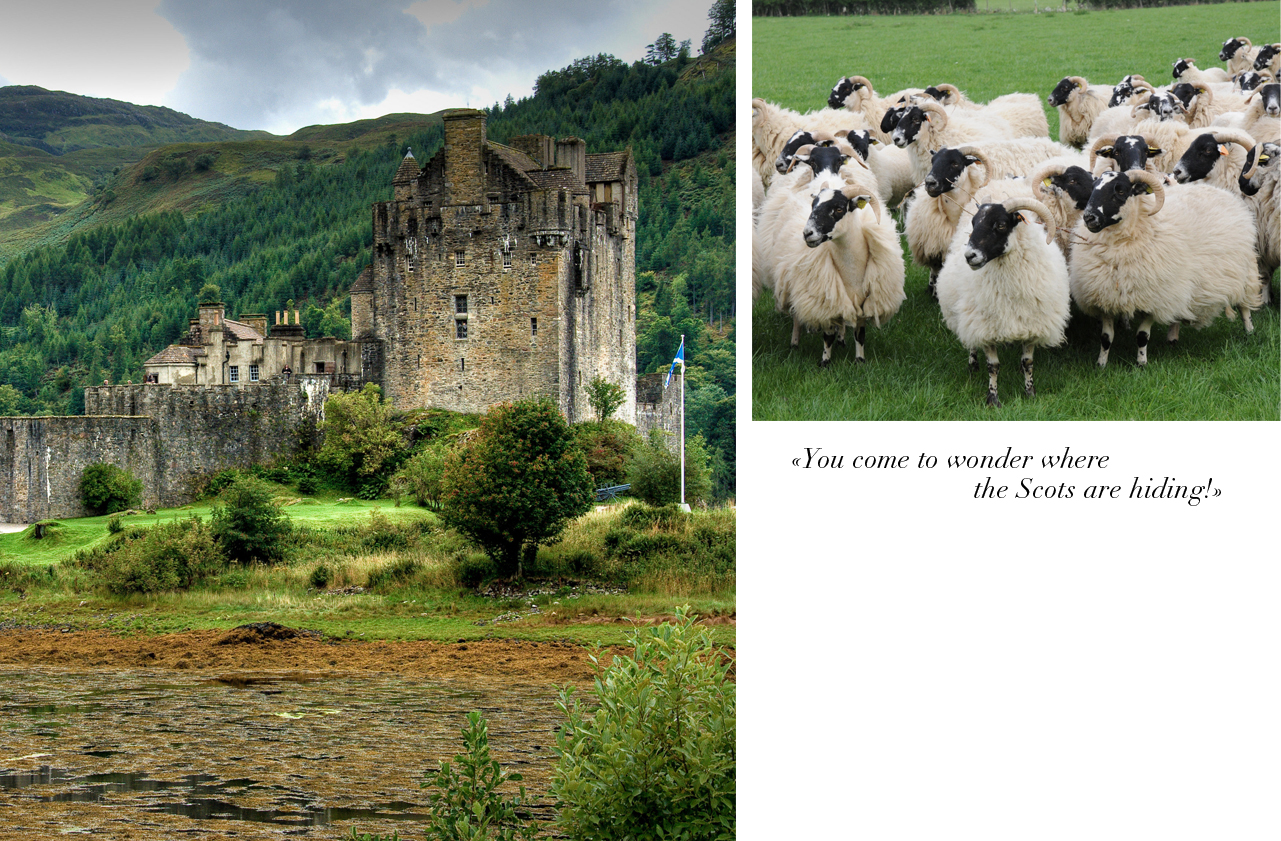
To drive across the Highlands, you take the only road that crosses Scotland from South to North. It can sometimes take you five hours to drive 120 miles, if you happen to be stuck behind a whisky truck on a two-lane road. That way, you get the time to look around at the superb landscape and its nuances of brown, yellow and purple. Just from the colors, you can tell what season it is.
In springtime, when all the flowers are in bloom, the entire horizon is pink. Moors for as far as the eye can see, lakes, sharp mountains: this is the Highlands. This is a truly atmospheric landscape. When you drive up North towards Dalwhinnie, on a plateau, you suddenly see the distillery: entirely white, like it is resting on a cashmere sweater.
One important piece of detail: do not forget to fill up your tank as there is no petrol station in sight. This is Scotland, but there is never anyone around to be seen. You bump into sheep, Scottish cows, and a whisky truck once in a while – but where are the Scots? That also is how you can tell you are in Scotland! The years go on and nothing changes. Every trip is an endless return to surreal, spectacular, moonlike landscapes.
-
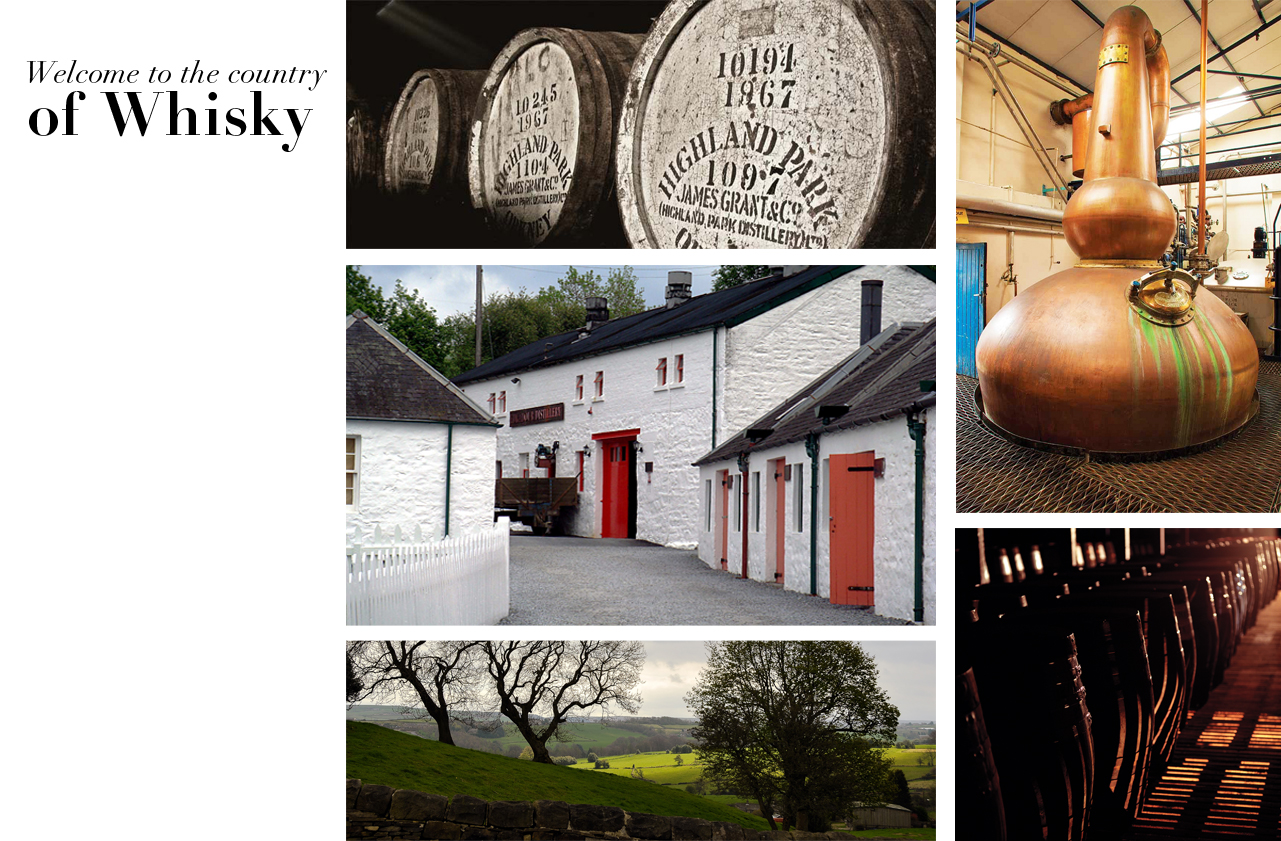
The region of the distilleries begins after you have crossed the Spey. You drive across the river and arrive in Elgin, a town with a lovely cashmere jumper factory. They are so expensive that you might want to go there during the sales.
In the Speyside, everything is green, very green, and hilly, and packed with rivers. There are sheep everywhere. The lawns are pristine. You feel like you are in Alice in Wonderland, or in the Wizard of Oz. Behind every grove of trees, at each turn of the road, you always see a distillery appear. Like at Trivial Pursuit, we have fun finding its name.
n Aberlour, we visit the famous distillery but also Walkers Shortbread, the famous factory of buttery biscuits.
In Scotland, the food is great. It is not creative food, but rather traditional and heartwarming, with simple tastes: meat, fish and seafood - always a pleasure to discover.
Further on, it is always nice to stop at Pitlochry. This very picturesque little village is home to Scotland’s smallest distillery: it looks like Snow White’s home, with a low roof and red shutters.
It is called Edradour, and belongs to Andrew Symington, who is both a producer and a trader. He owns a cave with ten thousand barrels. You can find treasures in there: I visit a dozen times a year and I’m just as awe-struck each time.
-
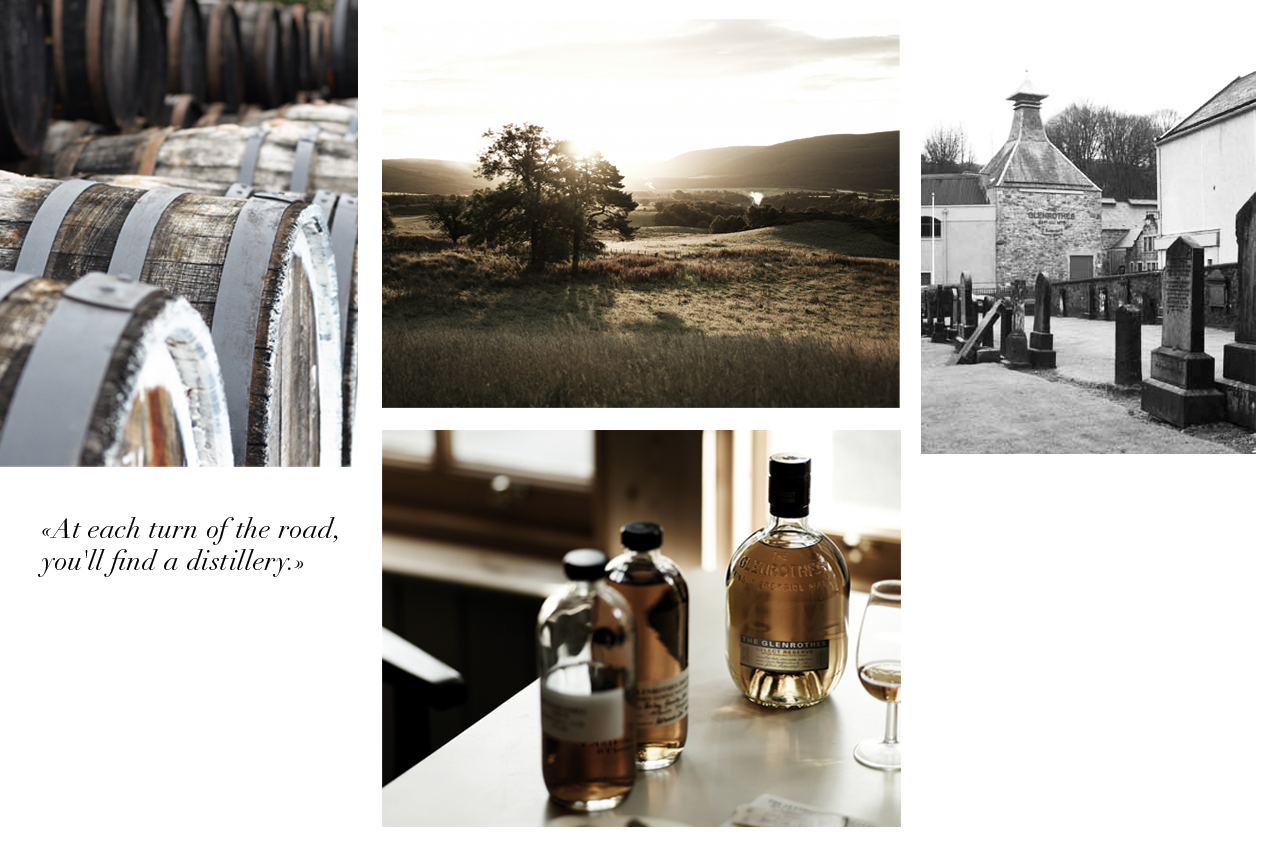
The Glenrothes is another of my favorite distilleries. Its whisky is very famous. I looked for the place at least a hundred times at Rothes without even finding it. That’s not surprising: it is hidden in the middle of a graveyard, amongst coal-black tombstones. It feels like being in a Tim Burton movie! It can be a bit tricky to visit, you need to book an appointment. They even have a cooperage.
The distillery in Dalmore has been entirely refurbished, but it has the oldest stills – one of them is from 1874. Its location alone, in front of the Black Isle, is worth a visit. And it offers some very old vintage whiskies, amongst the most expensive in the world. Do not miss out on Glenmorangie: its stills are the tallest in Europe.
In Dufftown, you must visit the room with the old stills in the Glenfiddich distillery, which makes one of the world’s best-selling whiskies. I used to have mixed feelings about the place.
I was wrong: its stills, with all their different shapes, are really worth a look. Then you can walk down a small footpath and after three hundred meters you’ll see Balvenie, which is very famous but not often visited by the public. This is one of the few distilleries where the barley is still mixed by hand.
-
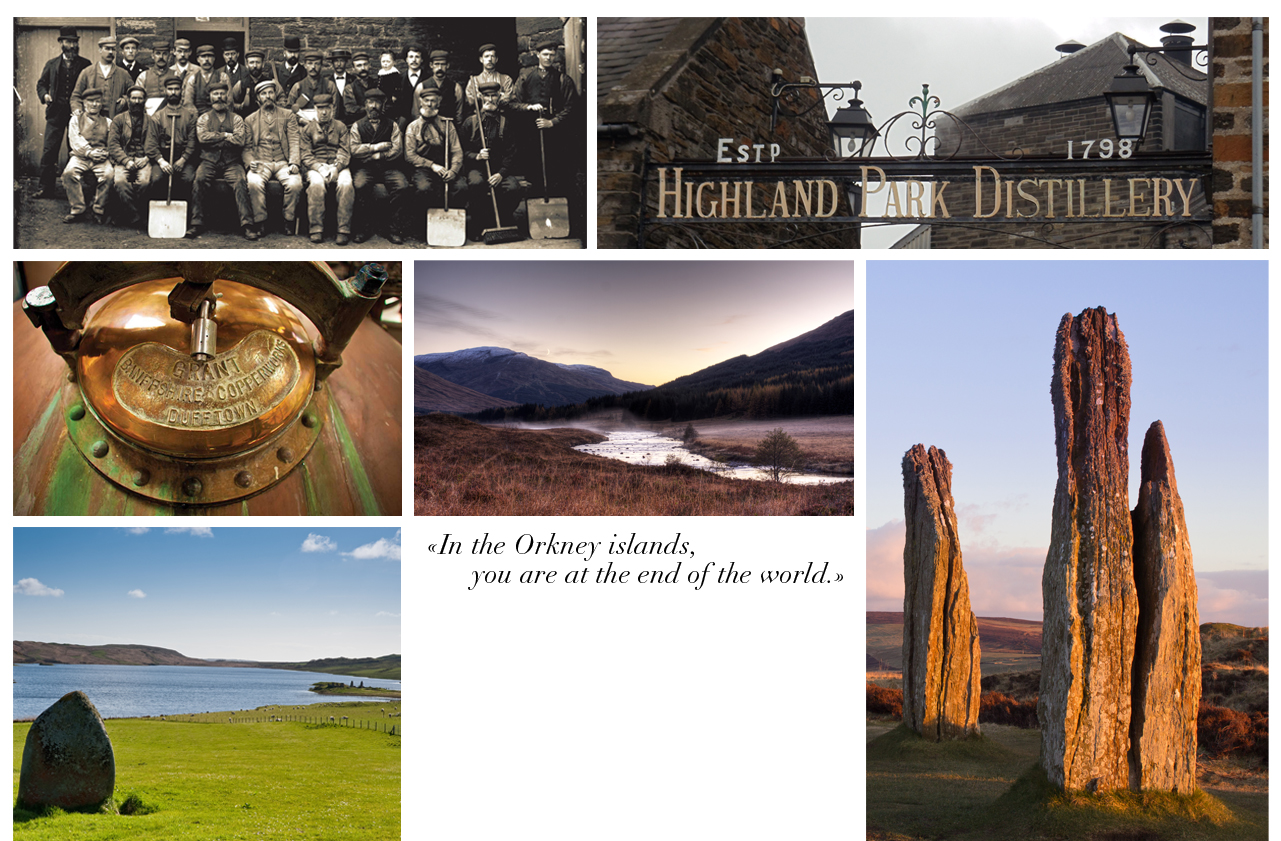
The further up North you go, the more the light changes. The vegetation becomes arid. There, at the very North, is the northernmost distillery: Old Pulteney. Under the influence of the sea spray, its whisky is slightly salty.
All of Scotland’s islands are incredibly charming, but I have a soft spot for the Orkney islands. There is nothing after them: you are at the end of the world. In the distance, you can see oil platforms. Depending on the weather, you can get there by boat or by plane. Only go there if you are not afraid of loneliness! The island has two distilleries: Highland Park, in Kirkwall, and Scapa, on the edge of the Scapa Flow. It was in this natural bay that the German fleet was destroyed in 1919, and you can still see the wrecks on the shore. A truly timeless place!
-
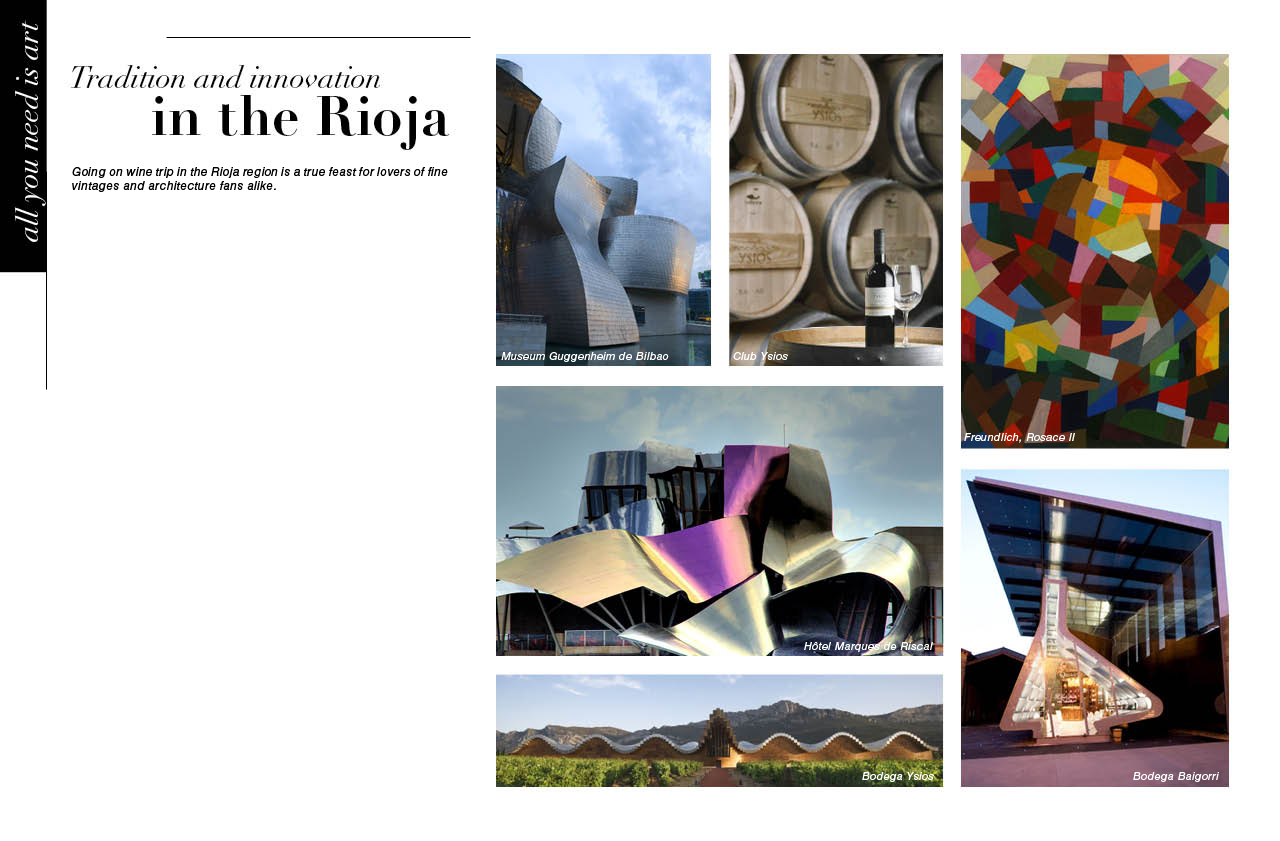
The city of Bilbao opened the way in 1997 by ordering from Canadian architect Frank Gehry an original building to host the Guggenheim Foundation’s collections. Gehry designed a stunning building whose curves are covered in titanium plates: the Guggenheim became an instant classic, and Bilbao turned into the symbol of Spain’s high-tech revival.
Following the trend, Marques de Riscal – the region’s largest winemaker – ordered from Gehry the “Ciudad del Vino”: a construction covered in tangled surfaces of titanium, whose undulations evoke the regions’ rolling hills. For all its boldness, the “city of wine” perfectly fits in with its environment. It has become a must-see, both for its architecture and for its indulgent facilities: a luxury hotel with a state-of-the art spa offering grape-based treatments; a bistro where you can sample the estate’s finest wines while contemplating the vineyards all around, and a Michelin-starred gastronomic restaurant headed by one of Spain’s greatest chefs.
The Marques de Riscal brought about a wave of followers: the village of Laguardia saw the apparition of a new generation of wineries with a difference: the Bodega Ysios, created by Santiago Calatrava, looks like a wave of barrels, or the Bodega Baigorri, designed by Basque architect Inaki Aspiazu.
Nearby, French architect Philippe Mazières created the Viña Real winery: a futuristic concrete construction that brings together cutting edge architecture with high-tech winemaking. And in the nearby village of Haro, superstar British-Iraqi architect Zaha Hadid has created a sci-fi bottle-shaped tasting room for the Lopez de Heredia winery.
This combination of a tradition of excellence with cutting-edge interventions has brought about a new momentum for the Rioja region. Perhaps a model for France’s most traditional winemaking regions…
-
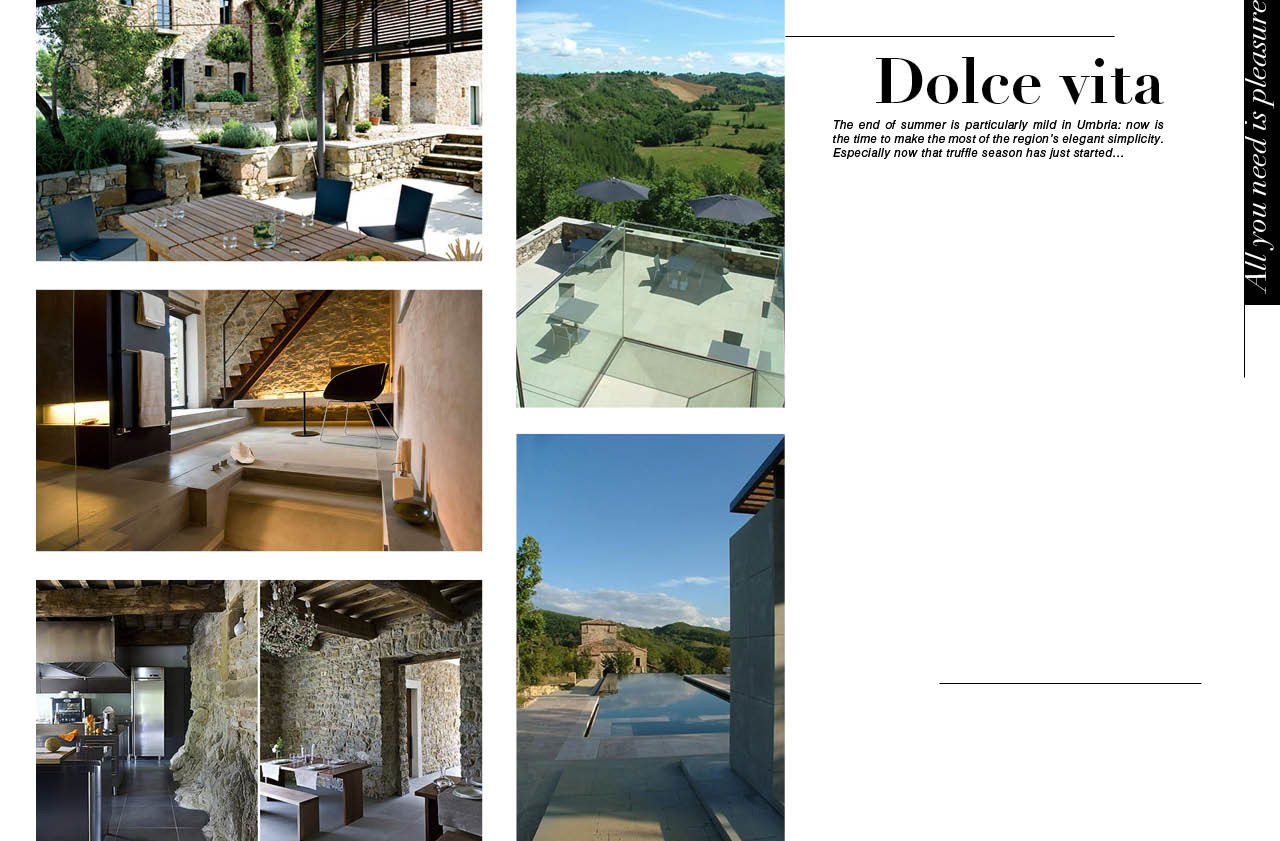
This boutique hotel used to be a watchtower in the 12th century. Perched atop a hill, it protected the neighbouring town and monasteries from invaders...The first time Seonaid Mackenzie and Christopher Chong set their eyes on the building, it was a ruin with no roof or walls. This didn’t stop them from falling in love with the place, lost in the middle of an oak tree forest. It took six years of renovation work to rebuild its structure, before tackling the interior design. Chong, an architect who has previously worked with Norman Forster and his interior designer wife have blended stone, concrete and steel to create a contemporary feel in complete harmony with the landscape, which appears through tall bay windows on every floor.
The place could feel austere, but instead it comes across as pure, peaceful and welcoming. The seven rooms, with views of the surrounding countryside, feel just right. Their coziness is enhanced by gentle lighting and voluptuous materials: an invitation to rest. The food is just as pleasure-inducing.
There is no menu or card: every morning at breakfast, the owner asks his guests for their desires of the day, and cooks generously for them. Tomatoes, olives and figs from the house’s organic garden, pork and pecorino from the neighboring farm… You can dine at candlelight on one of the garden’s terraces, or sip a glass by the infinity pool. Guided by Seonaid and Christopher, you will experience the genuine Umbrian lifestyle…
Torre di Moravola: 00 39 075 946 0965 www.moravola.com
Rooms from 200€ Our favorite room: the North Tower Suite with its panoramic views and a bathtub embedded in the stone floor.
Our favorite season: summer of course, but also fall for the truffles and the hunting.
-
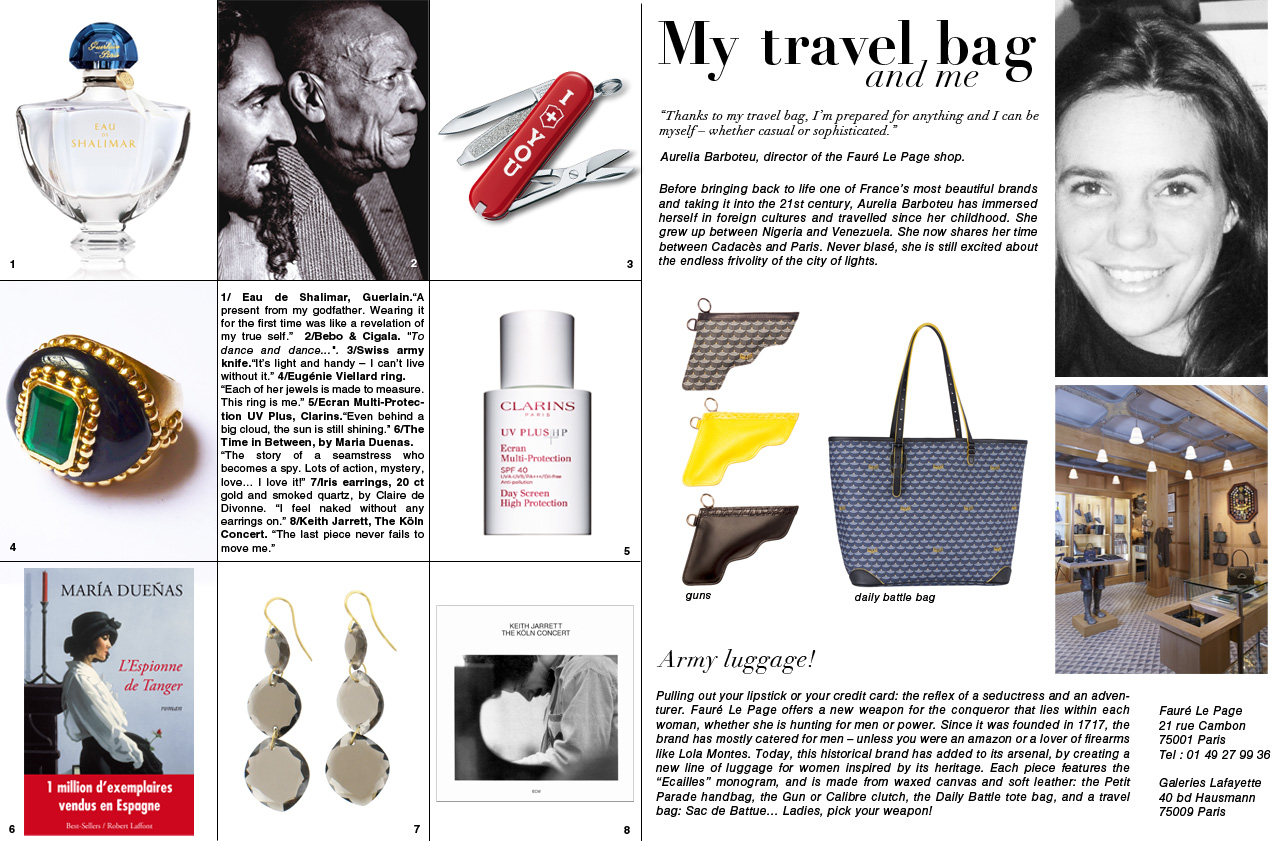
-
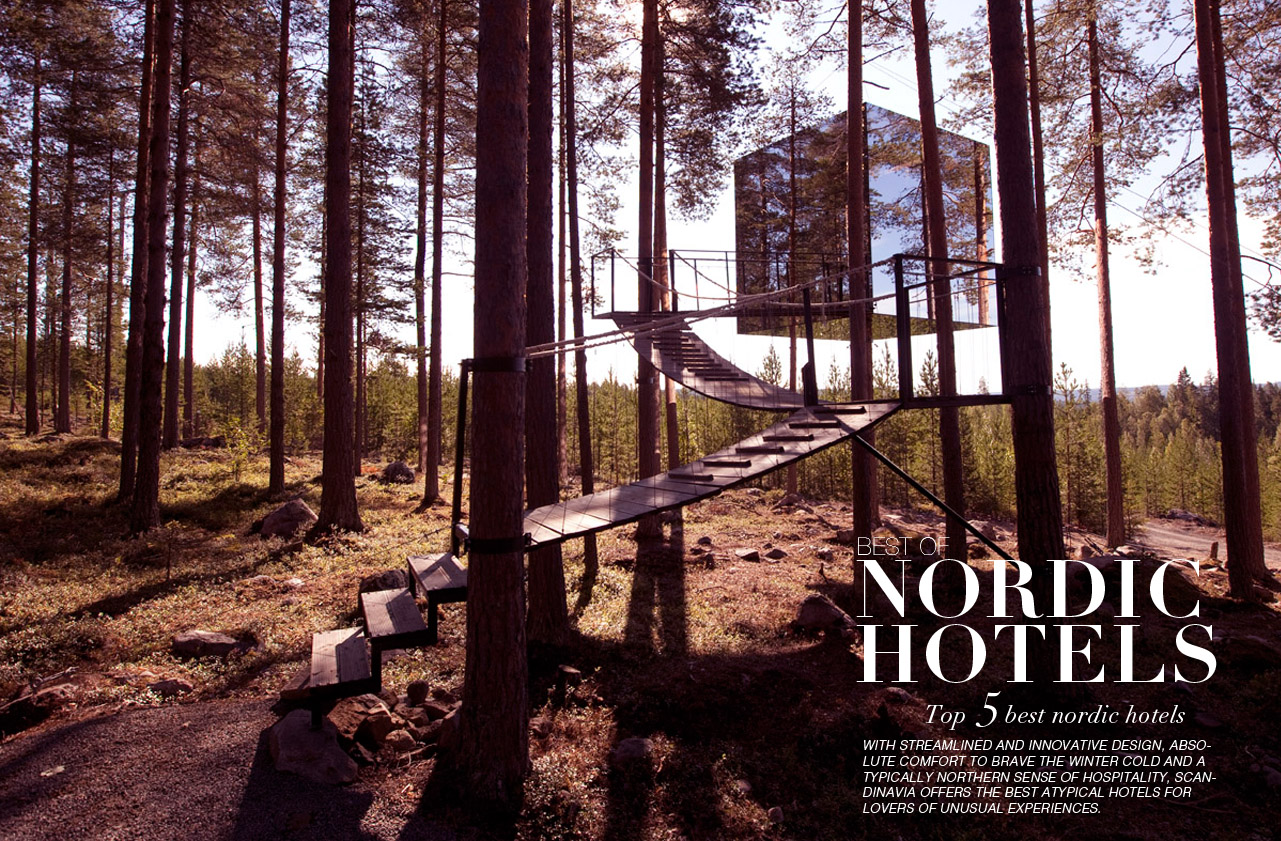
-
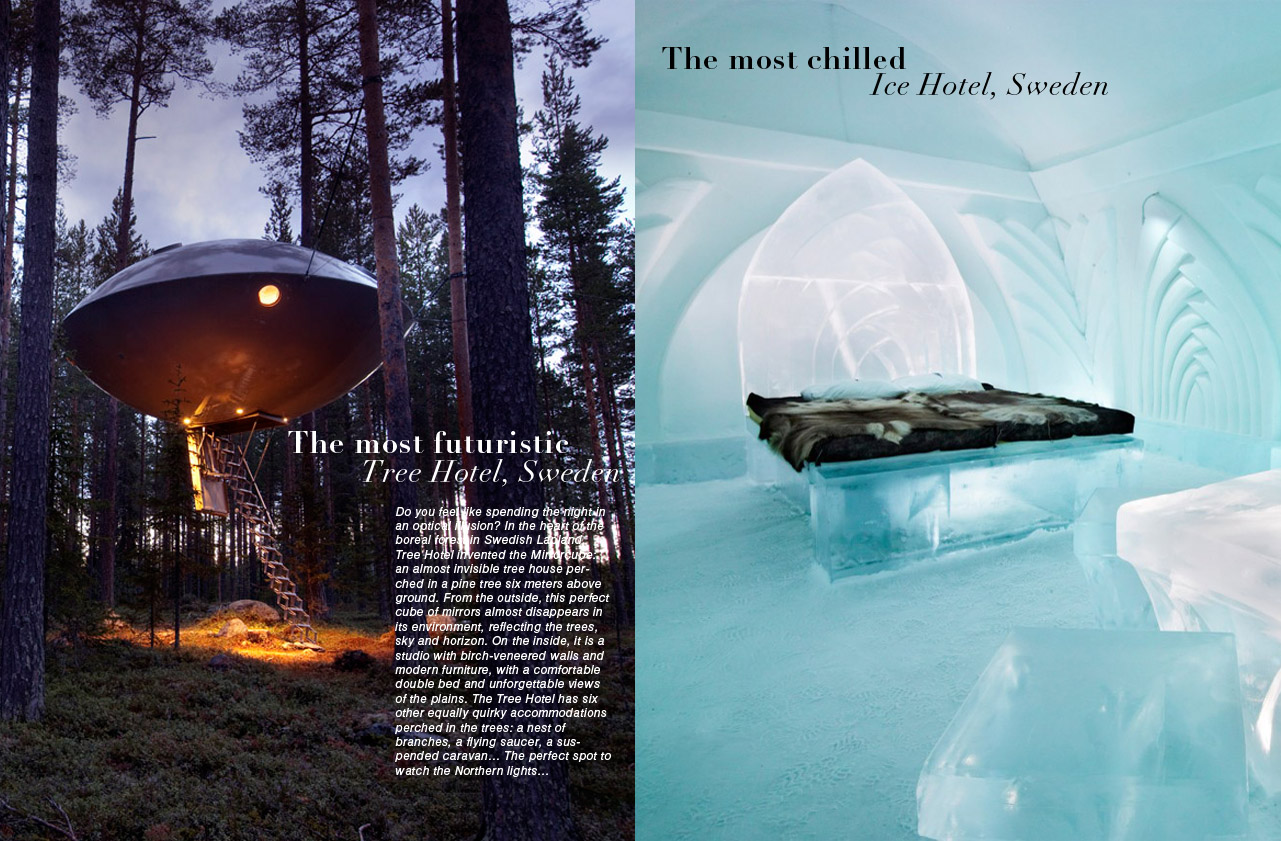
Halfway between an art installation and a luxury hotel, Ice Hotel gives you the chance to spend the night in a room entirely made of ice: protected from the cold by reindeer skins and a thermal sleeping bag, you will spend the night in a bed made of ice blocks, surrounded by ice and snow sculptures made by local artists using the waters of nearby river Torne. A surreal experience, and not so scary as it seems: in the rooms, the temperature never drops below -5°C, while it reaches -30° outside! You can also warm up with a glass of vodka, served on the rocks in an ice tumbler.
-
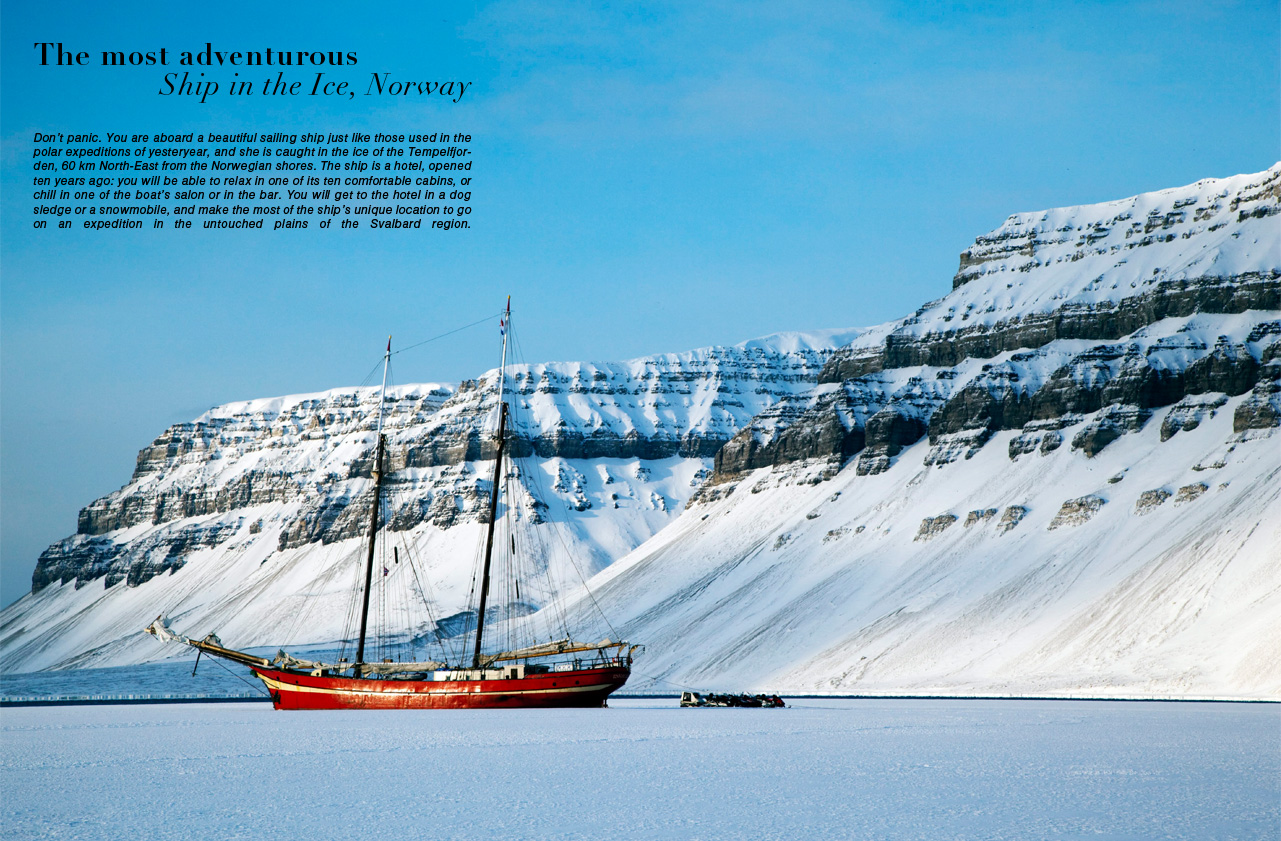
-
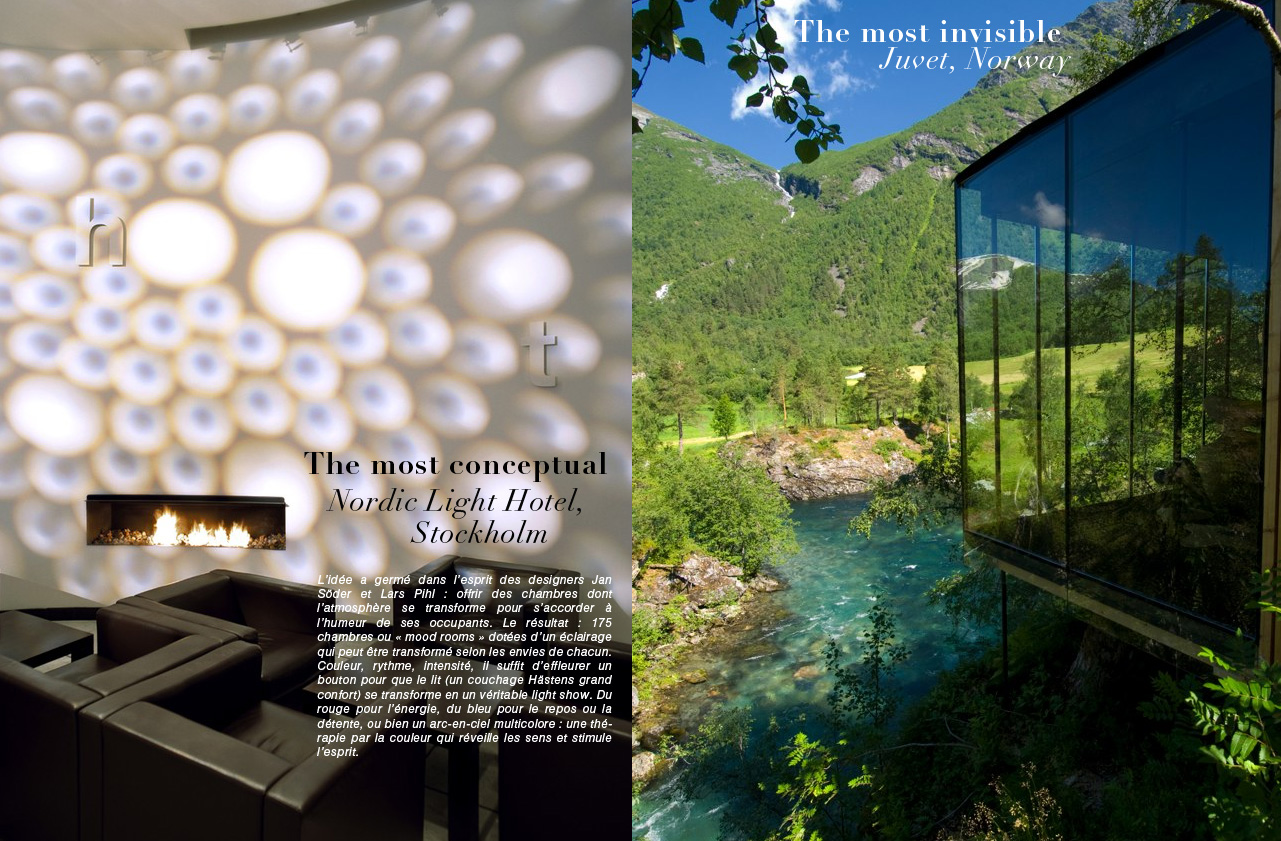
Because good design is perhaps about looking like it isn’t even there, Juvet invented the “landscape hotel”. In the heart of a natural park in North-West Norway, in each of the hotel’s seven minimalist pavilions, you will wake up to the sight of wind in the trees, snow on the mountaintops and the shimmer of an icy stream. The rooms, designed by Oslo architects Jensen & Skodvin, offer panoramic views. The walls and furniture in dark colors are almost invisible: the landscape is center stage. The rooms even have small shutters you can slide open to listen to the whisper of the river running nearby…
-
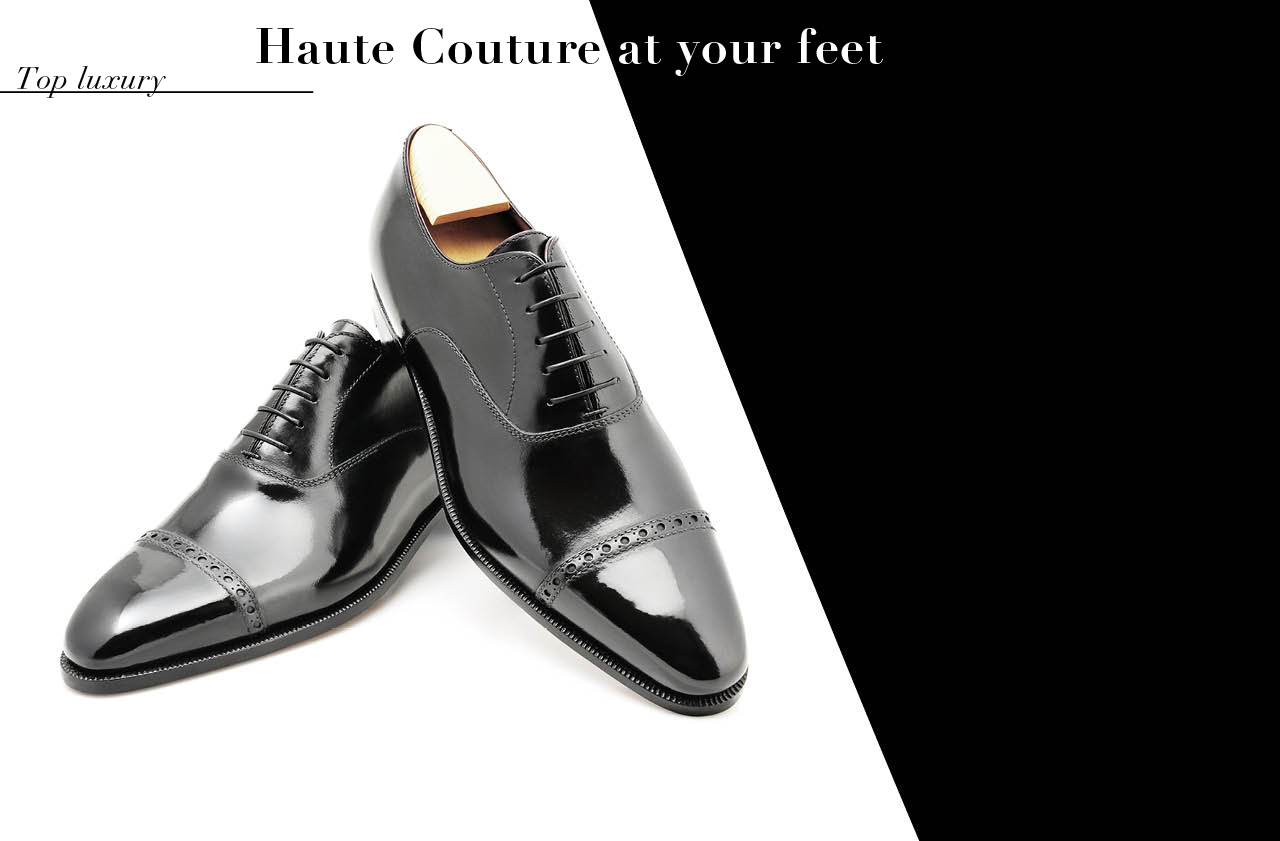
British brogues stand out for their robustness. Italian loafers for their softness. How about a pair of French Oxfords? Well, they should have both. In 1935 Emile Aubercy opened his men’s accessories shop in Paris. In the fifties, he specialized in men’s shoes. Today Xavier Aubercy, third generation shoemaker, is continuing the luxury and refinement of the family craft. When we visit the shop, one of the clients is an English Lord, who has come to try on a pair of Oxford boots to match his suits. Another is a foreign president… You will hardly meet two elegant gentlemen wearing the same pair of Aubercy shoes.
The catalogue offers about a hundred models and three lines of fabrication. The first is entirely made to measure. As with Haute Couture, the shoemaker creates a fitting model which is worn for a few weeks in order to check its comfort. The final model is then entirely handmade. The second line is handmade after an existing pattern. As for the luxury prêt-à-porter line, it is signed by Aubercy with its unique hand-stitched Goodyear sole. Slipping your feet into a piece of perfection is just a long-overdue return to true luxury - and indeed, to true fashion.
Boutique Xavier Aubercy
Adresse : 11 Rue Perronet, 75007 Paris
Téléphone :06 50 88 09 61
-
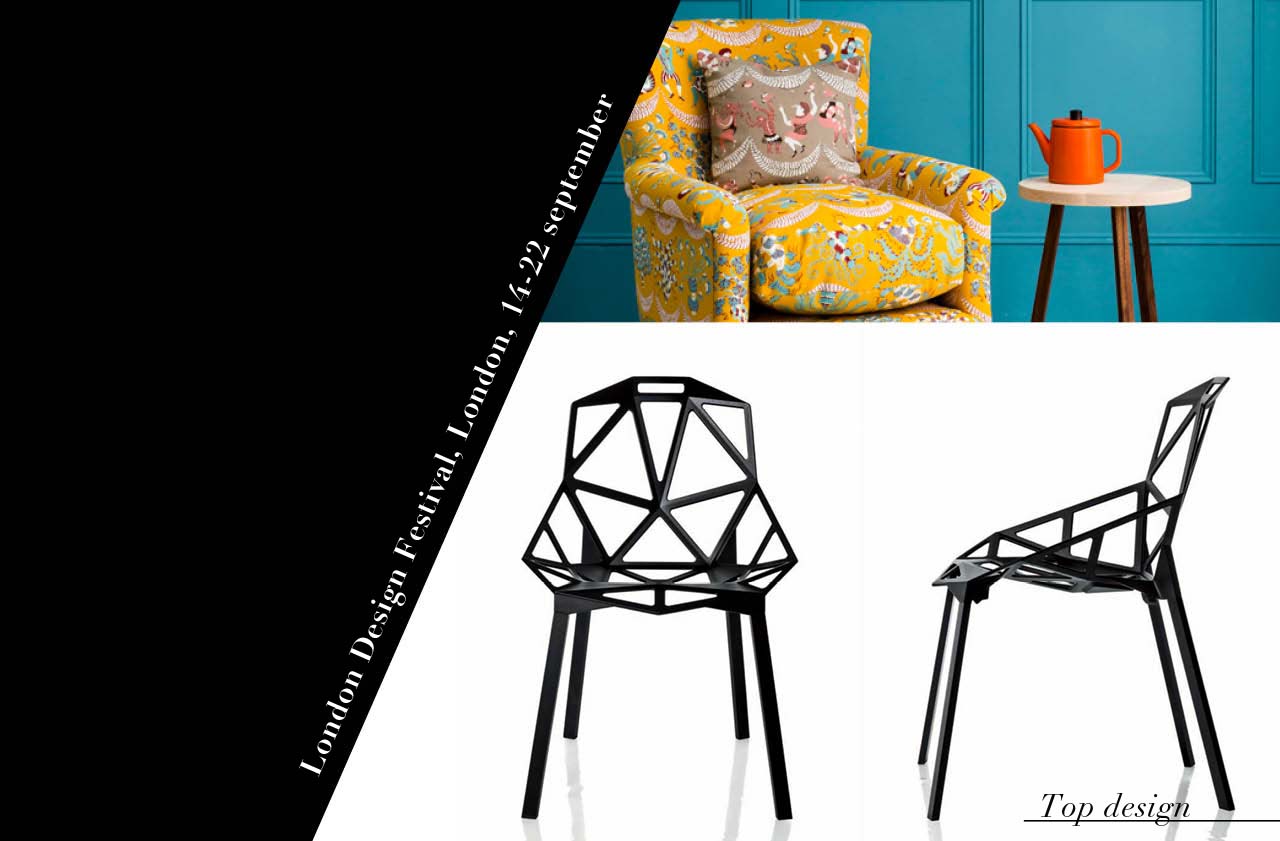
Every year in September, London is abuzz with its Design Festival, which will take place this year from the 14th to the 22nd September. Over 300 events and exhibitions will display the works of designers from all over the world, and from every sector of design – from furniture to product, from graphics to interiors. This is a must-see for fans of contemporary creation, with a chance to catch up on some of Britain’s big names: from veterans like Sir Terence Conran through to today’s trendier brands like Established & Sons, Tom Dixon or Jasper Morrison.
Head to Chelsea, South-West of Hyde Park: the area that used to be the beating heart of Swinging London has become the Mecca of contemporary design. Take a stroll around art galleries and cutting-edge design shops in the “Brompton Design District”. The Conran Shop, set in the beautiful liberty Michelin building, remains a must-see. Lovers of Nordic design, should not miss Skandium, the temple of Scandinavian design. Make sure you visit the Victoria & Albert Museum, London’s stunning museum of arts and design, which for a week becomes the Festival’s epicenter. In East London, in the “Shoreditch Design Triangle”, you will discover rising stars like Sebastian Wrong or the collective Åbäke. All around the area, look out for temporary art galleries and pop-up shops: the young designers of Design Marketo take over Redchurch Street, and the old tram station on Rivington Street, the Tramshed, turns into an über-chic gallery. As promised by the festival’s programme, “Design Is Everywhere”!
http://www.londondesignfestival.com/
-
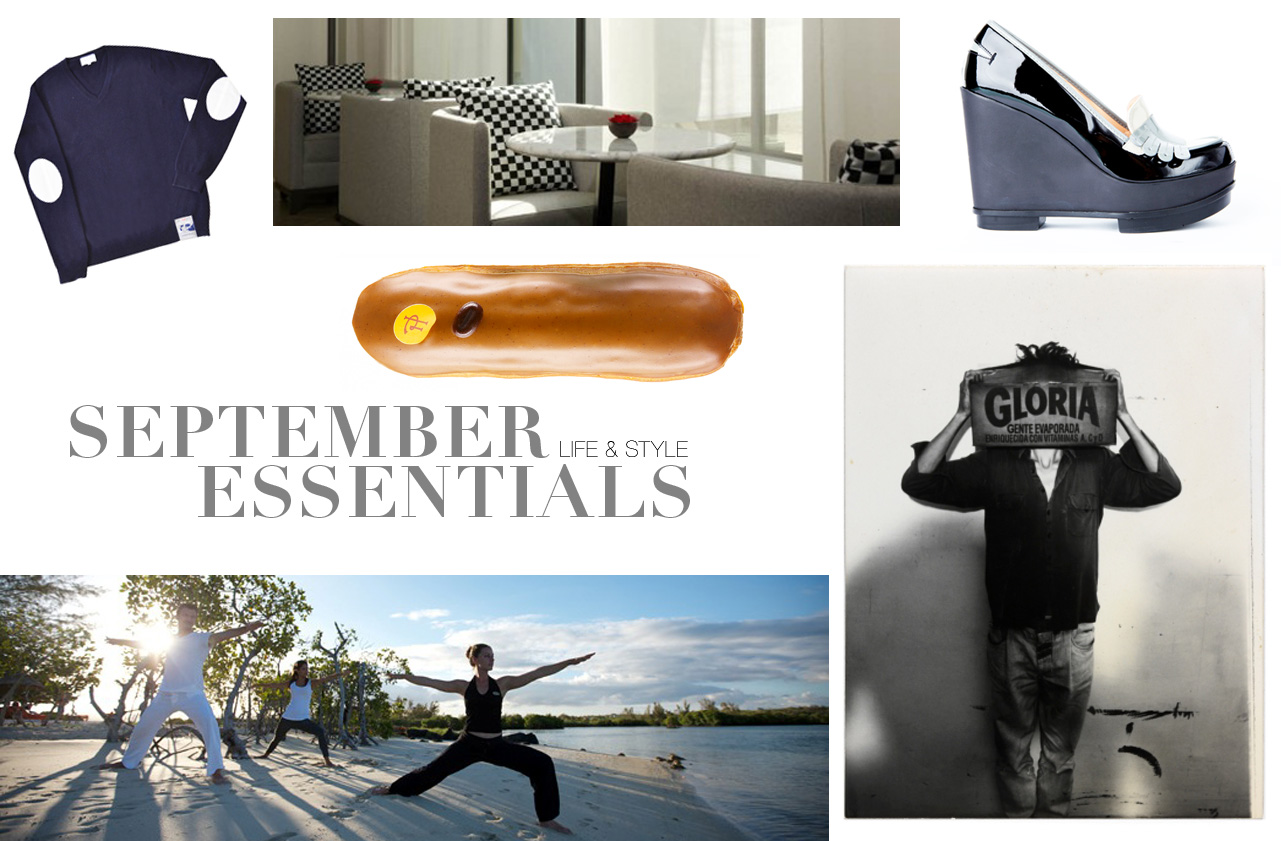
-
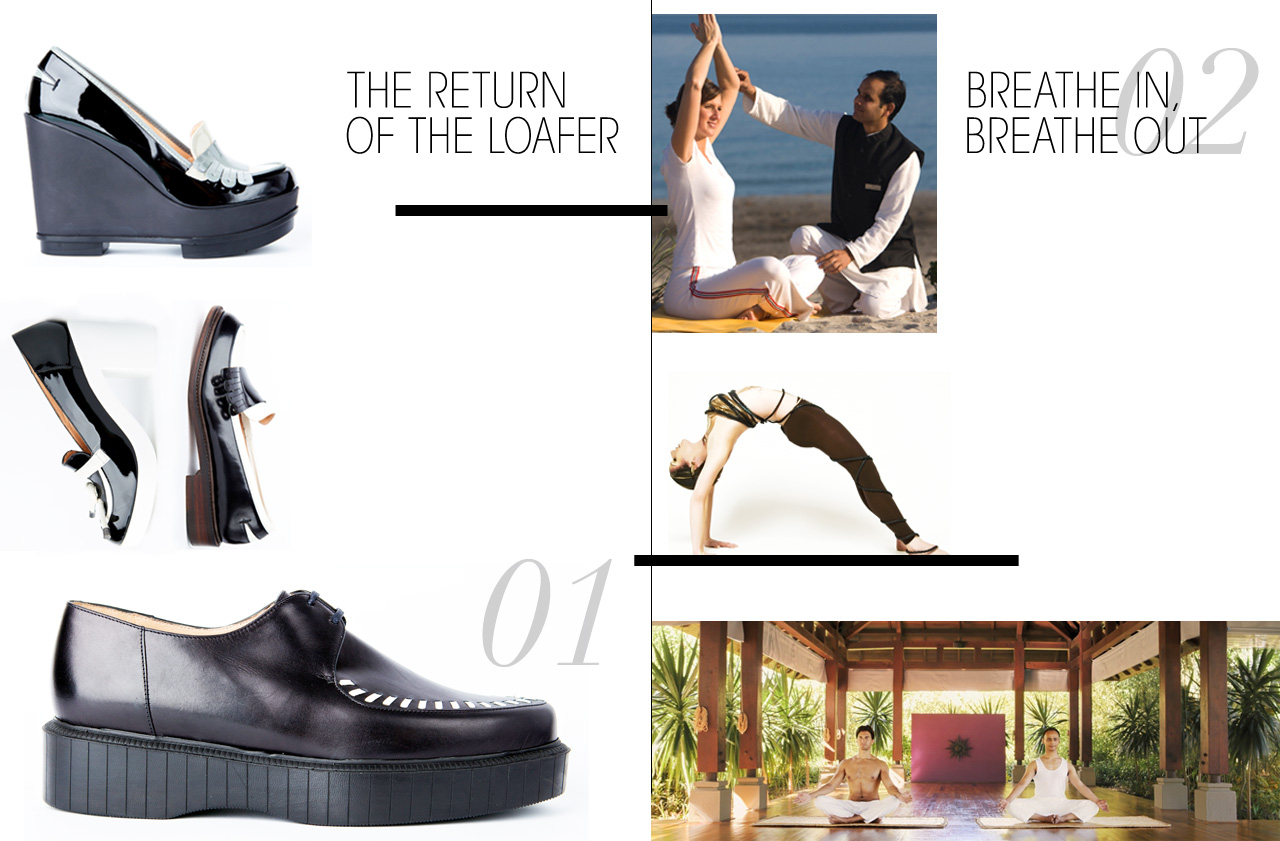
After seasons spent on stilettos, it’s time to get back on flat ground. Or almost… Borrowed from masculine shoewear, the loafer is having a great comeback, spearheaded by Robert Clergerie. Roland Mouret, the label’s Creative Director, is paying a tribute to the 80’s – a time when ladies used to walk like men…
More feminine, with platforms or high heals, the shoe retains a certain grandeur – with a nod to vintage style and two-tone, and a tribute to Yohji Yamamoto’s style. And they are just as sexy with a skirt as with trousers.
If you only have to chose one activity for this September, it has got to be yoga. Hatha, asthanga, nidra… Yoga takes over every gym, bringing serenity to stressed out and tired urbanites. People even practice on holiday – to the point where they will select a spot based on the hotel’s yoga coach.
In Germany, the Grand Hotel Helligendam offers a five-day yoga package on the banks of the Baltic sea, led by Indian Master Anjay. In Mauritius, at the Constance Prince Maurice, you can relax and breathe with yoga guru Isabelle Lamant, who created a method based on classical dance, pilates and floor barre. At the Shanti Maurice, you can take part in a custom-made programme, complemented by ayurvedic treatments. And once you are back home, you can practice your stretches and keep in shape at Virginie Boe’s class for busy Parisians.
-
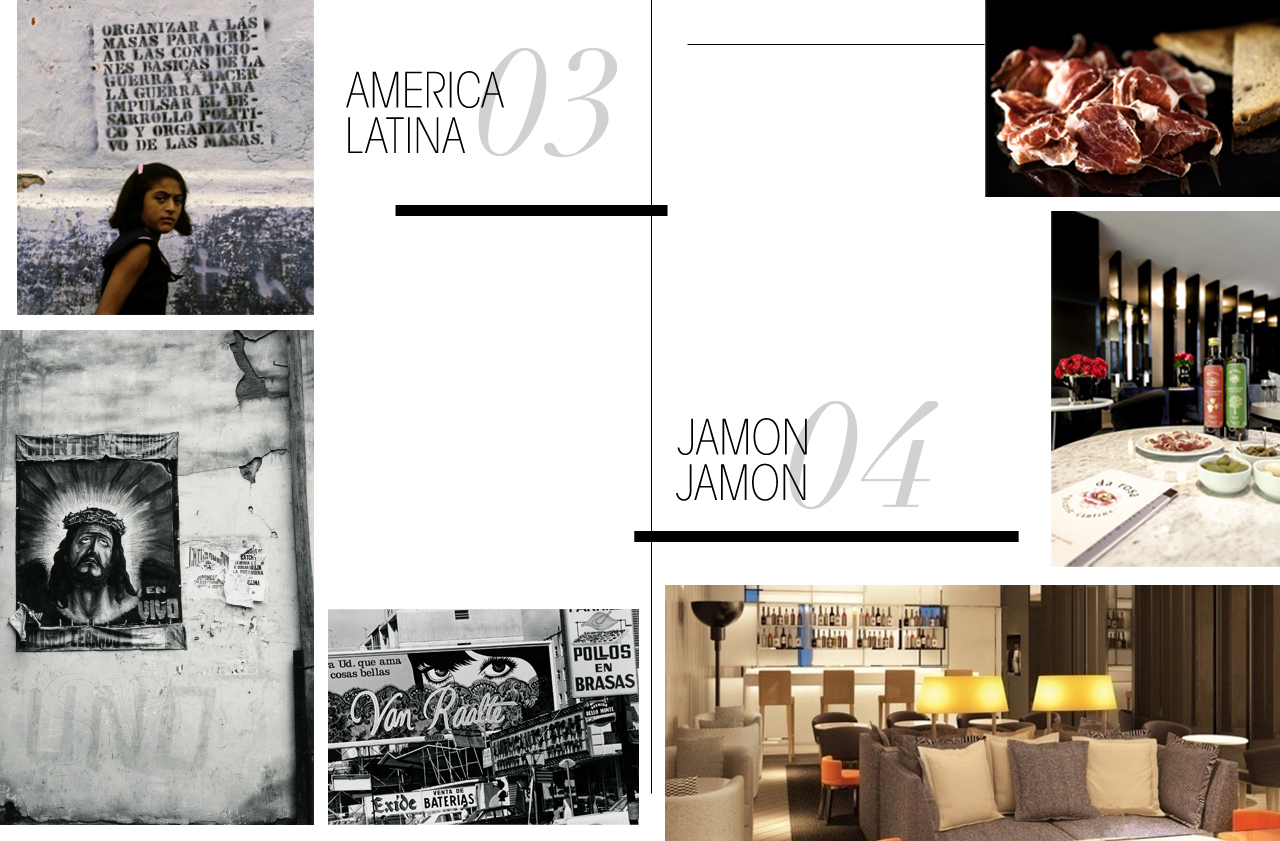
The largest retrospective ever dedicated to Latin American photography. Covering 1960 to 2013, the show at the Fondation Cartier pour l’Art Contemporain presents works by over 70 artists from 11 countries. These political, social and cultural pieces immerse us in the continent’s hectic contemporary history.
Image is not just a medium for expression and freedom: Chilean Eugenio Dittborn’s works involve play on words, Argentinian Juan Carlos Romero presents screen prints, Brazilian Regina Silveira shows collages… To make those works even more powerful, Paraguayan director Fredi Casco created a series of interviews with the artists, in a vivid and moving film.
Do you fancy some tapas tonight? Head to the Bar Da Rosa at the Sofitel Arc de Triomphe. José Da Rosa’s favorites feature on the menu: jamon, lomo, Bellota chorizo iberico, Salamanca olives…
On the side, treat yourself to a slice of Pan Con Tomate, a portion of albacore tuna ventresca. Or indulge in a salmon burger, to be savoured with a glass of Sangria da Rosa, of authentic Venetian Spritz or of Coletti Proseco. Summer is not over yet…
-
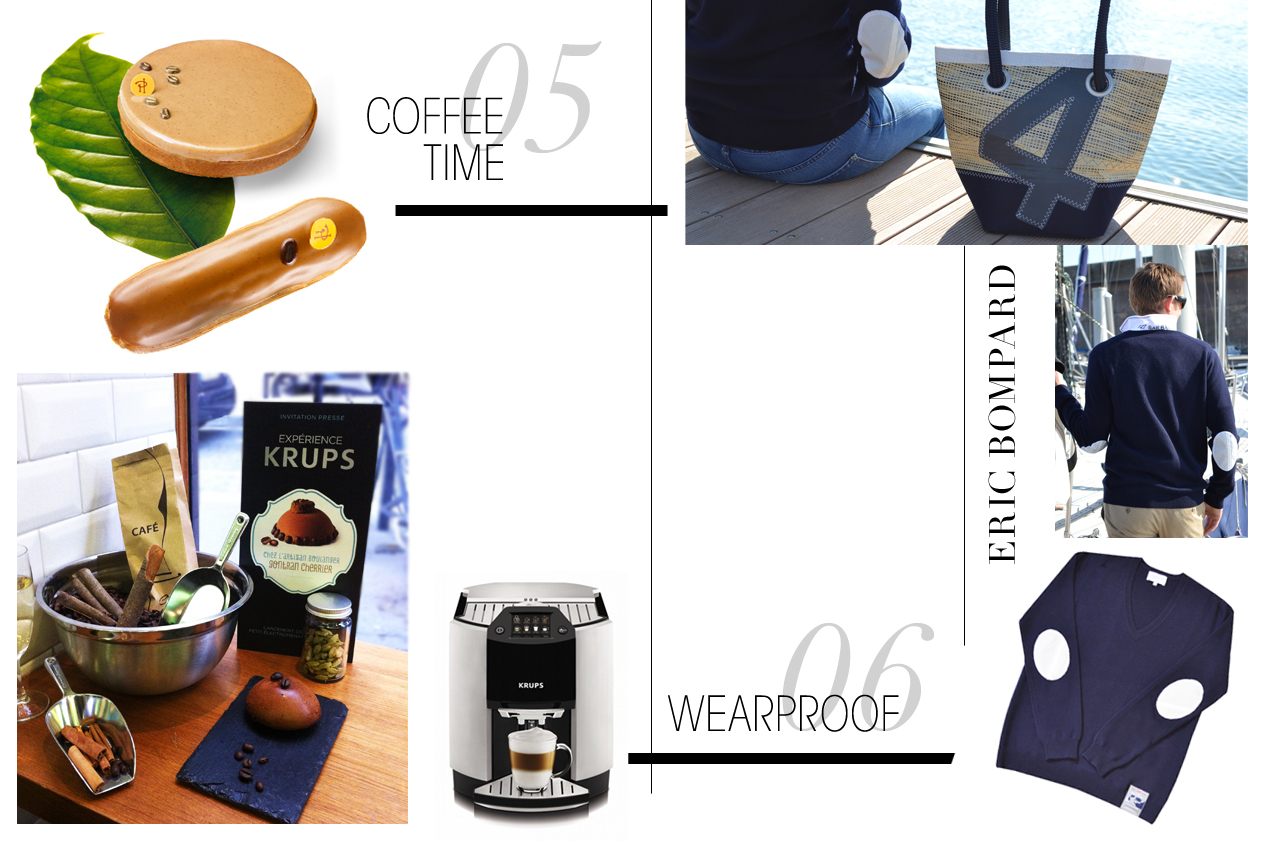
Thank you Georges. Tea is out, now is coffee time: prestigious vintages, new-style roasteries, baristas and high-tech coffee machines. Krups just launched the Espresso Full Auto, with a tactile screen to control your grains’ grinding and your ristretto’s intensity. At Starbucks in the Galeries Lafayette, you can chose between gentle or strong espresso. Illy proposes a menu of salty snacks to complement its coffees, and coffee is taking over patisserie. Throughout September, Gontran Cherrier offers three coffee-based deserts. Pierre Hermé serves a “Fetish Café” collection, with mokas, éclairs and coffee tarts to die for. And the Maison du Chocolat offers scrumptious ganaches, perfumed with great vintages of coffee.
Pretend you are a weathered sailor, or just give your cashmere the right touch of second hand chic: slip into this Bompard sweater, with customized elbow patches by 727 Sailbags. The idea for this limited edition series - which of course only comes in one color: navy blue! - was born from the encounter between two fans of sailing races: Eric Bompard and Erwann Goullin. The founder of 727 Sailbags recycles old sails: the elbow patches on this cozy jumper have been cut from the sails of Jérémie Beyou, the winner of the 2011 Solitary race.
-
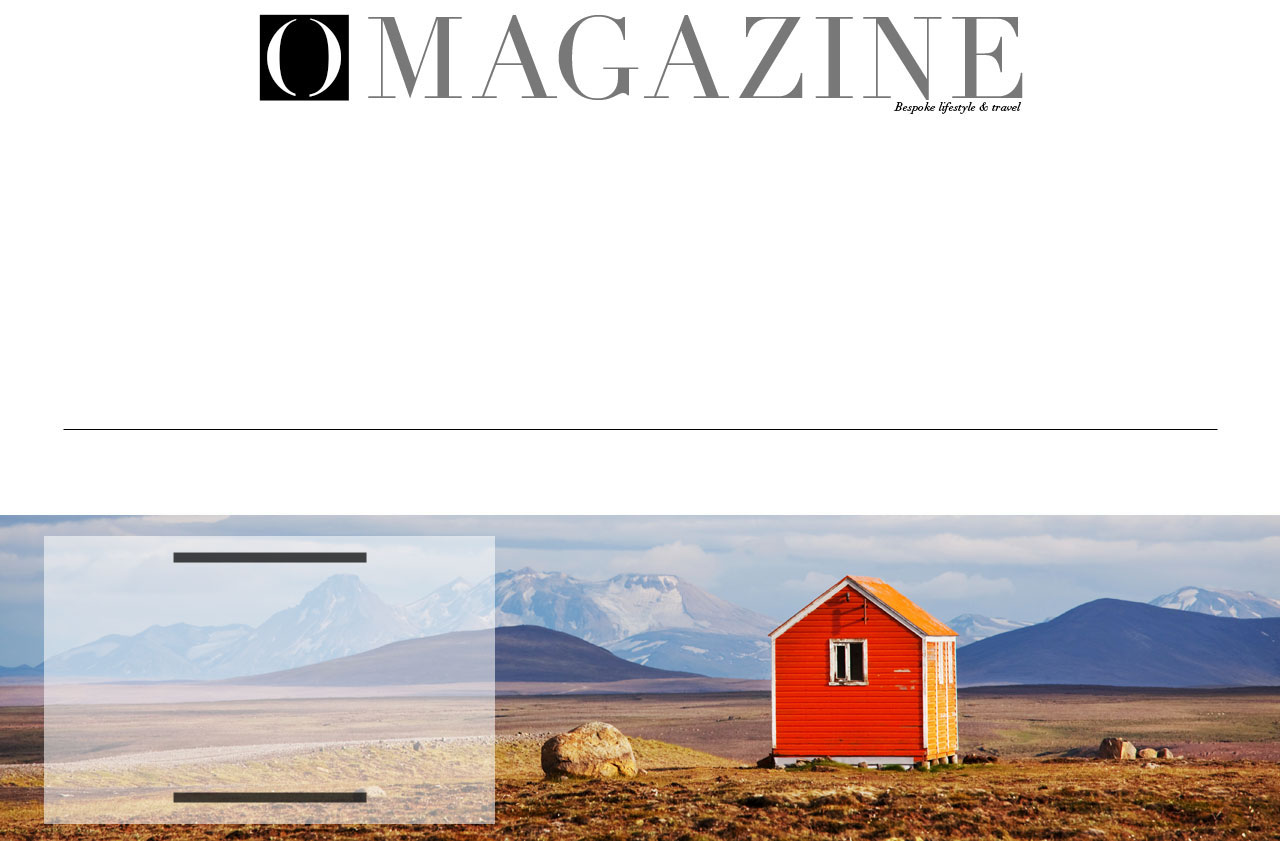
Editorial director JORGE APESTEGUIA
Chief editor CATHERINE JAZDEZWSKI
Art director LUDIVINE PARET
Editor VALENTINES LEŸS
Marketing manager LAURA VASSART
IN NEXT MONTH’S MAGAZINE..
Live an icelander winter
A guided tour of London by Paul Smith,
who will be the object of an upcoming
retrospective at the DesigColor of the most beautiful indian
summer of the century
Archives

